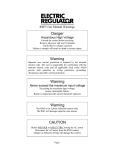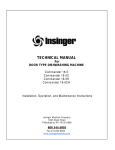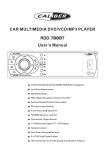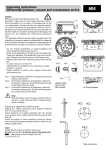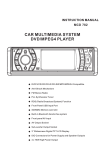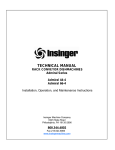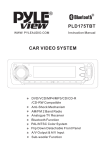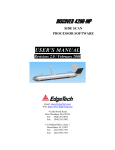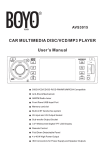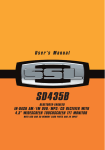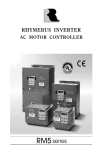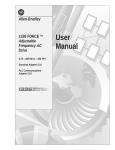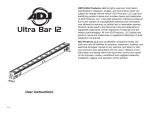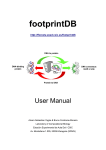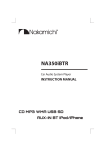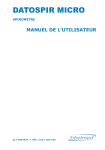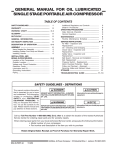Download User Manual - Electric Regulator Corporation
Transcript
A RM5G Supplemental User Manual Danger Hazardous High Voltage Ground the control before servicing Remove all power and wait until all the control has discharged. Measuring the voltage of terminals P and N to verified it has discharged. Failure to comply will result in death or serious injury. Warning Separate over current protection is required by the national electric code. The user is responsible for conforming with the national electric code and all applicable local codes which govern such practices as wiring protection, grounding, disconnects and other current protection. Warning Never exceed the maximum input voltage Exceeding the maximum input voltage causes catastrophic failure. Repair is impractical the control should be replaced. Warning The RM5 is for 3 phase induction motors only. The RM5 will damage capacitor start motors. CAUTION Before MEGGER or DIELECTRIC testing the AC motor. Disconnect the AC motor from the RM5G control. Megger or dielectric testing will damage the control. RM5G Supplemental Users Manual Page 2 RM5G Supplemental Users Manual Table of Contents Pg. 5 Pg. 5 Pg. 5 Section 1) 1.1) 1.2) 1.2) Model Number Scheme Pg. 7 Pg. 7 Pg. 8 Pg. 9 Pg. 9 Section 2) 2.1) 2.2) 2.3) 2.4) 2.5) Physical Installation Operating Environment Motor Selection AC Line Reactors Wire Size & AC Power and Motor Connections Carrier Frequency Section 3) 3.1) 3.2) 3.3) 3.4) 3.5) Section 4) 4.1) 4.2) 4.3) 4.4) 4.5) 4.6) 4.7) 4.8) 4.9) 4.10) 4.11) 4.12) 4.13) 4.14) 4.15) 4.16) 4.17) 4.17) 4.18) 4.19) 4.20) 4.21) 4.22) 4.23) 4.24) 4.25) 4.26) 4.27) 4.28) The Fundamentals Keypad Operation Programing with positive and negative numbers Operating the RM5 without the keypad How to restore the factory program Quick Guide (to the most used program codes) Programming Instructions Stop, Start, Forward and Reverse Analog Inputs and Transferring Inputs Analog Input Scale Digital Speed Input Analog Outputs Digital Outputs Keypad Default Display User Defined Meter (i.e. MPM) Auxiliary Digital Meters Digital Meter Connection Diagram Frequency Scale of Acceleration and Deceleration Acceleration and Deceleration Secondary Acceleration and Deceleration S-curve starting, leveling and stopping Speed Range (Frequency Range) Frequency Range Bypass Dynamic Brake Resistor Dynamic Braking (DC Braking) External Dynamic Braking Unit Installation Motor Rating and Overload Parameters Motor Slip and Stall Parameters Level Speed Detection Signal Voltage Frequency Patterns (V/F Pattern) Motor Starting Parameters Carrier Frequency (i.e. Switching Frequency) Holding the Motor Stationary Power Interruption Pass-through Power Interruption Controlled Stop Program Store and Copy Programs Pg. 10 Pg. 10 Pg. 10 Pg. 10 Pg. 11 Pg. 13 Pg. 14 Pg. 15 Pg. 15 Pg. 16 Pg. 16 Pg. 17 Pg. 17 Pg. 17 Pg. 17 Pg. 18 Pg. 18 Pg. 18 Pg. 18 Pg. 19 Pg. 19 Pg. 20 Pg. 21 Pg. 21 Pg. 22 Pg. 23 Pg. 23 Pg. 24 Pg. 25 Pg. 25 Pg. 25 Pg. 26 Pg. 26 Pg. 27 Receiving and Specifications Physical Inspection Input Power and Motor Specifications Page 3 RM5G Supplemental Users Manual Pg. 27 Pg. 27 Pg. 27 Section 4) 4.29) 4.30) 4.31) Restoring the Factory settings Locking Programs & 400 Hz Motors Fault History Pg. 31 Pg. 31 Pg. 32 Pg. 33 Section 5) 5.1) 5.2) 5.3) 5.4) Analog Keypad KP-202 (Optional Feature) Analog Keypad Factory Settings Changing the LED display Programming the adjustment Pots (ADJ) DIP Switch Programming Pg. 34 & 35 Pg. 35 Section 6) Fault Codes Fault Code Table Clearing Faults (Reset) Pg. 39 Pg. 39 Pg. 40 Pg. 41 Pg. 42 Pg. 43 Pg. 45 Pg. 50 Page 4 Programming Instructions continued Appendix Keypad Physical Dimensions Diagram Dynamic Braking Unit (DBU) Physical Dimensions ½ to 5 HP Physical Dimension Diagram 7 ½ to 150 HP Physical Dimension Diagram Electric Power Specifications Common Specifications Function Code Table Elementary Wiring Diagram RM5G Supplemental Users Manual 1. Receiving & Storage Section 1.1 Physical Inspection When you receive the RM5G AC drive, avoid shock or vibration when unloading and transporting the unit. This can damage the semiconductors or other components. Immediately upon receipt inspect the unit for the following; y Check to be certain the unit is clean of packing materials. y Check for damage incurred during shipment, dents, scratches, etc. y Inspect mechanical the parts, loose screws, terminals, etc. y Inspect for, damaged, loose or shorted electronic components or connections. y If you find damage, don’t connect power to it. The unit must be replaced or repaired. Connecting power could result in fire or further damage and could void warranty. Promptly report damage or problems you found during inspection to Electric Regulator Corp. Telephone (760) 438-7873 Fax (760) 438-0437 Store the AC drive in a clean dry place in the package it was in shipped. Avoid storing the unit in a location with high temperatures, humidity, dust or corrosive gases. Outdoor storage is not recommended. Section 1.2 Input Power & Motor Rating Check the identification label to confirm that the input power and the motor’s ratings are compatible with the drive. y Identification Label On the right side of the drive please find the label with the model number, input power and output power. Example:: Model No. RM5G-2005 Input Power 200 to 230 VAC 50/60Hz Output Power 3.7kW/ 5 HP 17A y Model Number Scheme RM5G - 2 005 A B C A: RM5G........... Model Series Number B: 2.................... Voltage 208V, 220V, 230V 4.................... Voltage 400V, 440V, 460V C: 005................ Horsepower: Example 5 HP y Input Power Units rated from ½ HP to 5 HP can use 1 or 3 and above require 3 input power y Motor Specification Inverter duty motor compatible with IGBT variable frequency control. input power. Units 7 ½ HP Page 5 RM5G Supplemental Users Manual Page 6 RM5G Supplemental Users Manual 2. Installation Location 2.1 Operating Environment The RM5G AC drive should be located in a operating environment that meets the following conditions. y y y y Ambient Temperature between 14o to 122o Fahrenheit (-10o to 50o Celsius). Relative Humidity Avoid locations exceeding RH 90%. Condensation Do not locate the unit where condensation occurs. Altitude If located above 1000m/3280 ft above sea level, see table for power derating. y y y Corrosion Avoid locations with corrosive gases or liquids; example: ocean air. Contamination Avoid locations subject to dust or iron particles. Hazardous Gases & Liquids The RM5G is not designed for explosive environments. Do not locate the unit were it is subject to combustible or flammable gases or liquids. Ventilation Mount the unit in a lengthwise vertical position to ensure proper cooling ventilation. Provide not less than 5 inches (125 mm) top and bottom and 2 inches (50 mm) each side of clear space around the unit. If the unit is in a sealed enclosure, provide adequate ventilation for air flow from top to bottom. Shock & Vibration Avoid mounting the unit in a location subject to shock or vibration. y y 2.2 Motor Selection y y y y y The motor should be a standard three phase induction motor. The minimum insulation requirement is 100 M at 500V. Most modern motors meet or exceed this requirement. Submersible motors may fail due to sand and other contaminates abrading the insulation. If the normal speed is above 15 Hz a self ventilated motor normally adequate. If the motor speed is under 15 Hz for more than several minutes, separately powered ventilation for the motor is required. The resonance frequency of a typical motor is somewhere between 6 Hz to 9 Hz. If you plan to run close to the resonance frequency, read page 16 section 4.16, Frequency Bypass. If you run the motor above 60 Hz, see page 27, section 4.29 Page 7 RM5G Supplemental Users Manual 2.3 AC Line Reactors AC line reactors should be used, if the RM5's input power is shared with 4 or more AC drives or equipment with SCR thyristors, high power motors or welders. Important, the AC line reactor should be located as close as possible to the input terminals of the RM5 AC drive. 200~240V Table HP Inductance 1 2 3 5 7.5 10 15 20 25 30 40 50 60 0.4 mH 0.4 mH 0.4 mH 0.3 mH 0.3 mH 0.08 mH 0.08 mH 0.04 mH 0.04 mH 0.04 mH 0.03 mH 0.02 mH 0.02 mH Page 8 440~480V Table Amperes HP Inductance Amperes 15A 15A 15A 30A 30A 50A 50A 100A 100A 100A 150A 200A 200A 1 2 3 5 7.5 10 15 20 25 30 40 50 60 75 100 150 200 300 0.4 mH 0.4 mH 0.4 mH 0.4 mH 0.3 mH 0.3 mH 0.25 mH 0.25 mH 0.08 mH 0.08 mH 0.04 mH 0.04 mH 0.04 mH 0.03 mH 0.02 mH 0.02 mH 0.03 mH 0.03 mH 15A 15A 15A 15A 30A 30A 40A 40A 50A 50A 100A 100A 100A 150A 200A 300A 560A 560A RM5G Supplemental Users Manual Section 2.4 Wire Size Table and AC Power and Motor Connections Input: 220 VAC / 3 Phase / 60 Hz Input: 460 VAC / 3 Phase / 60 Hz HP 200% Load AC Amps Recommended Wire Size Circuit Breaker AC Amps at 250VAC 1 2 3 5 7.5 10 15 20 25 30 40 50 60 75 100 125 150 3.9 7.9 11.8 19.68 29.52 39.36 59.05 78.73 98.41 118.09 157.46 196.82 224.38 295.24 393.65 492.06 590.47 14 AWG 14 AWG 14 AWG 12 AWG 10 AWG 8 AWG 6 AWG 4 AWG 3 AWG 1 AWG 00 AWG 000 AWG 0000 AWG 300 MCM 500 MCM (2) 250 MCM (2) 350 MCM 5 10 15 25 30 40 70 90 100 125 175 200 225 300 400 500 600 HP 200% Load AC Amps Recommended Wire Size Circuit Breaker AC Amps at 600VAC 1 2 3 5 7.5 10 15 20 25 30 40 50 60 75 100 125 150 1.9 3.8 5.7 9.41 14.12 18.83 28.24 37.65 47.07 56.48 75.31 94.13 112.96 141.2 188.27 235.33 282.4 14 AWG 14 AWG 14 AWG 14 AWG 14 AWG 12 AWG 10 AWG 8 AWG 8 AWG 6 AWG 4 AWG 4 AWG 3 AWG 1 AWG 00 AWG 0000 AWG 250 MCM 5 5 10 10 15 20 30 40 50 60 75 100 125 150 200 250 300 Output: Variable 0 ~ 60 Hz / 0 ~ 220 Volts Output: Variable 0 ~ 60 Hz / 0 ~ 460 Volts HP 200% Load DC Amps Recommended Wire Size for 40 ft length HP 200% Load DC Amps Recommended Wire Size for 40 ft length 1 2 3 5 7.5 10 15 20 25 30 40 50 60 75 100 125 150 3.9 7.9 11.8 19.68 29.52 39.36 59.05 78.73 98.41 118.09 157.46 196.82 224.38 295.24 393.65 492.06 590.47 14 AWG 12 AWG 12 AWG 10 AWG 8 AWG 6 AWG 4 AWG 2 AWG 1 AWG 0 AWG 0000 AWG 250 MCM 300 MCM 500 MCM (2) 250 MCM (2) 350 MCM (2) 500 MCM 1 2 3 5 7.5 10 15 20 25 30 40 50 60 75 100 125 150 1.9 3.8 5.7 9.41 14.12 18.83 28.24 37.65 47.07 56.48 75.31 94.13 112.96 141.2 188.27 235.33 282.4 14 AWG 14 AWG 14 AWG 12 AWG 12 AWG 10 AWG 8 AWG 8 AWG 6 AWG 4 AWG 3 AWG 2 AWG 1 AWG 00 AWG 0000 AWG 300 MCM (2) 000 AWG Elementary Power Connection Diagram RM5 AC Drive Optional motor thermostat connections X5 COM For normally closed thermostat program F056 to -7. For normally open thermostat program F056 to 7. PE R S T P PR U V W Thermostat Earth Ground is recommended but not required T3 T2 Output: Varable Hertz & Volts T1 Inverter Duty AC Motor If the output wires exceed 40 ft Lower the carrier frequency. (See section 2.2) Optional Line Reactor When four or more drives are connected to one set of power lines, line reactors are recommended Earth ground of the motor's frame is recommended but not required. L1 L2 L3 Input: 60 Hz Section 2.5) Carrier Frequency Longer wires require lower carrier frequency. Function code F 081 programs the carrier frequency. Wire Length ½ to 5 HP 7 ½ to 10 HP 15 to 30 HP 40 to 75 HP F 081 10m / 40 ft 12.5 kHz or less 10 kHz or less 7.5 kHz or less 5 kHz or less Carrier Frequency 25m / 80 ft 10 kHz or less 7.5 kHz or less 5 kHz or less 2.5 kHz Factory set: 4 50m / 160 ft 7.5 kHz or less 5 kHz or less 2.5 kHz 2.5 kHz 1) 2.5 kHz 2) 5.0 kHz 3) 7.5 kHz 100m / 320 ft 5 kHz or less 2.5 kHz 2.5 kHz 2.5 kHz Over 100m 2.5 kHz 2.5 kHz 2.5 kHz 2.5 kHz 4) 10.0 kHz 5) 12.5 kHz 6) 15.0 kHz Page 9 RM5G Supplemental Users Manual Section 3.1) Keypad Operation The keypad has four operating modes. y Monitoring Mode (default) y Data Mode (Meter) y Function Code Menu (Scrolls up and down from F 000 to F 134) y Programming Mode (Edits the function codes) Light is on when the speed is controlled by the keypad Light is off when the speed is controlled by the terminals In Operating mode the LED displays meter functions In Programming mode the LED displays the function settings KEYPAD Signals the meters display mode Hz V RPM A MPM Flashes during acceleration and deceleration TS RUN (i.e. Start) PROG enters and exits programming mode PROG RUN In Operating mode FUN scrolls through the meter functions In Programming mode DATA enters and exits the "F" codes FUN DATA STOP RESET In Operating mode the arrow keys adjust the speed In Programming mode the arrow keys scroll and edit the "F" codes Stop or RESET clears faults When the power is switched on, the keypad LED display is in monitoring mode. In monitoring mode the default display is the frequency (Hz) output to the motor. The default display can be changed to the user’s preference. Function code F 006 selects the default display, see the table below for function code F 006. Example of how to program. In this example you will change the default display to RPM. Press the PROG key to enter the function code menu. The function codes are numbered from F 000 through F 134. Then use the arrow keys to scroll up and down through the function codes, scroll to F 006. To change the program of F 006, press the FUN/DATA key to enter F006. Then used the arrow keys to scroll to the number 6 (RPM, see table below) then press the FUN/DATA key to exit F 006 and then press the PROG key to exit out of the function code menu. The default display should now be RPM. F 006 Keypad Default Display (Factory set: 1) Function code table for F 006 1) Hz 4) DC Supply Voltage 2) Speed setting in Hz 5) Current 3) Voltage 6) RPM 7) User Defined Meter 8) Terminal Status Section 3.2 Programing with positive and negative numbers. The input and output terminals programs have positive and negative numbers. Positive numbers are for closed circuit and negative numbers are for open circuit. An example of when programing with negative numbers is required. The motor thermostat is normally closed until the temperature becomes too high and then opens. In this circumstance terminal X5 that is programmed by F 056 should be programed to negative seven (-7). When the motor is cool the thermostat closed and the motor is permitted to run. If the motor becomes too hot the thermostat opens and the motor stops. Section 3.3) Operating the RM5G with out the keypad. The RM5G will operate without the keypad, when the RM5 is controlled by terminals Vin, GND, FWD and REV. If more programing is required reconnected the keypad. Section 3.4) How to Restore the Factory Program Settings. Press the PROG key to enter function code menu, then scroll to F 134 and press the FUN/DATA key. Then scroll until dEF60 is displayed, press and hold down the FUN/DATA key until the word “end” is displayed. When the word “end” is displayed. All the function codes have been set to the factory 60 Hz settings. Page 10 RM5G Supplemental Users Manual Section 3.5) Quick Guide (to the most used program codes) This page covers the most commonly used function codes for quick reference. The RM5G default settings are for keypad operation. The motor will start when the run key is pressed and the arrow keys adjust the speed. When the RM5G is started for the first time, it will accelerate to 60 Hertz. If you do not want run at 60 Hertz, before starting, press the down arrow key to adjust the speed, then start. Most users will want to program the following parameters y Motor Voltage users of 440V ~ 480V motors will need to program F 034. y Speed Control Input users that have speed potentiometers will need to program F 002. y Start and Stop users that have auxiliary start and stop buttons will need to program F 001. y Stop the user should select controlled deceleration or coast (freewheeling), see F 082. y Acceleration and Deceleration times are programmed by F 019 and F 020. y The motors number of poles see F051 y Maximum Current enter the motors maximum amps listed on the data plate into F 048. Note: Measure the output voltage with a True RMS digital meter or analog meter. Analog meters are preferred. 0) Enable FWD and REV terminals to start, keypad start is disabled. Start, 1) Enable FWD and REV terminals to start, forward rotation only. F 001 Forward & Reverse 2) Keypad Start, Terminals select forward or reverse. 3) Keypad Start, forward only. Factory set: 3 Notes: Settings: 0, 1, 2. If FWD, COM or REV, COM are not connected the keypad flashes, - - - - - . If both FWD, REV are connected simultaneous to COM the keypad flashes, def. F 002 Speed Control F 003 Keypad Stop F 006 Keypad Default Display F 019 F 020 F 035 F 047 F 048 F 049 Acceleration Time Deceleration Time Maximum Output Voltage Over Current Switch Off Time Motor’s Maximum Current Rating Motor’s No Load Current Rating F 051 Number of Poles F 082 Stop Deceleration F 095 Input Voltage 0) Speed Pot Terminals: 12V,Vin, GND or Current Ref.., Iin, GND 1) Keypad Arrow Keys with Hz display. Factory set: 1 2) Keypad Arrow Keys with RPM display when arrow keys are pressed. 3) Keypad Arrow Keys with user defined meter displayed when arrow keys are pressed. (See F007) 4) Digital Speed Input, terminals X2 trough X6 0) Disable Keypad Stop 1) Enable Keypad Stop, Factory set: 1 1) Hz Output 5) Current 2) Speed Setting in Hz 6) RPM 7) User Defined Meter. Note see F002 number 3 3) Voltage 4) DC Link Voltage 8) Terminal Status Factory set: 1 0 to 3200 sec. Factory set: 1/2 to 5 Hp 5 sec, 7.5 to 30 Hp 15 sec, 40Hp & up, 30 sec. 0 to 3200 sec. Factory set: 1/2 to 5 Hp 5 sec, 7.5 to 30 Hp 15 sec, 40Hp & up, 30 sec. 200V series, 0.1V ~ 255V, Factory default: 220V 400V series, 0.1V ~ 510V, Factory default: 380V 0) Standard switch off time. Factory set : 0 1) Fast switch off time See motor's name plate for the maximum current rating See data on motor’s name plate for no load current rating. If not available on name plate measure the current. Factory set: 0.1 Entering the motor’s number of poles calibrates the RPM and the User defined meter (See F007) . Select: 2P, 4P, 6P, 8P, 10P. Factory set: 4P 0) Controlled Deceleration Stop 1) Uncontrolled Deceleration Stop (coast to stop) 200V series, 190V ~ 240V, Factory default: 220V 400V series, 340V ~ 480V, Factory default: 380V Page 11 RM5G Supplemental Users Manual Page 12 RM5G Supplemental Users Manual Section 4.1) Start, Stop, Forward and Reverse The RM5’s default program is to start and stop from the keypad. Many alternat methods beyond the diagrams shown here are possible. 0) Enable Terminals FWD and REV to Start and Stop (Keypad is disabled) F 001 Start, Stop, Forward and Reverse 1) Enable Terminal FWD to Start and Stop 2) Keypad Start (i.e. Run), Terminals FWD and REV select direction 3) Keypad Start (i.e.Run), Forward only (Factory set: 3) F 003 F 056 F 057 F 052 F 053 F 054 0) Disable Keypad Stop 1) Enable Keypad Stop (Factory set: 1) Keypad Stop Stop (Digital Input X5 Close) Stop (Digital Input X6 Open) Emergency Stop (Freewheel, Coast to Stop) F 082 Stop F 083 Reverse When terminal X5 (F 056) is set: 0. Stop is achieved by momentarily closing X5 and COM for not less than 30 ms. This facilitates interfacing with PLC or momentary stop button. Note: When F 056 is set: 0. Terminals FWD and REV only require 30 ms signal to start. Sustaining the signal to FWD or REV is no longer required. When terminal X6 (F 057) is set: 0. Stop is achieved by momentarily opening X6 and COM for not less than 30 milli seconds. This facilitates interfacing with PLC or simulation of a three line sustaining circuit. Note: When F 057 is set: 0. Terminals FWD and REV only require 30 ms signal to start. Sustaining the signal to FWD or REV is no longer required. When the application requires both controlled deceleration stop button and uncontrolled deceleration stop button (Some electrical codes require Emergency Stop to coast to stop). Program one of the terminals, X1(F 052) or X2(F 053) or X3(F 054) to !9. 0) Controlled Deceleration Stop (Factory set: 0) 1) Uncontrolled Deceleration Stop (i.e. Freewheeling, Coast to stop) 0) Enable Reverse (Factory set: 0) 1) Disable Reverse Examples of start, stop circuits Classic Three Line Sustaining Circuit RM5 AC drive 120V Simulated Three Line Sustaining Circuit START STOP FWD F001 set: 0 or 1 FWD F001 set: 0 or 1 RUN 1a START RUN RUN 2a COM RUN 1c STOP RM5 AC drive COM X6 F057 set: 0 RUN 2c Note: When F001 is set 0 or 1, the input signal must be sustained. Forward and Reverse using pulse signals Note: When F001 is set 0 or 1 and F057 is set 0. Then FWD and REV only require a momentary input signal. Start & Stop circuit with momentary buttons FWD 60 Hz STOP 0 Hz START RM5 AC drive FWD F001 set: 0 or 1 REV 60 Hz Pusle Width Minimum 30ms COM FWD REV Clearing Time Mininum 30ms. X5 STOP X5 F056 set: 0 Note: F001 is set 0 and F056 is set 0. When changing direction, first a stop signal next a REV or FWD signal. Page 13 RM5G Supplemental Users Manual Section 4.2) Analog Inputs and Transfering Inputs Analog inputs are also know as speed referance inputs. y y y y The RM5 has two analog inputs: Vin (voltage input) and Iin (current input: RL=500 ). The primary analog input is Vin and the secondary is Iin. The speed referance can be transfered while the motor is running. To transfer speed reference inputs see F122, F 55 and the X terminal table for F052 ~ F057. The Iin terminal can be changed to a voltage input by dip switch DSW1. The position I is for current reference (RL 500), position V is for voltage reference (RL= 20k). The scale of Vin and Iin can be defined by the user, see F 040, F 041, F 126, F 127 and F 128. The Vin and Iin inputs can be program perform other functions such as current limit, voltage limit, bias and gian. see F 124 and F 125. F 002 Speed Adjustment Input F 052 F 053 F 054 F 055 F 056 F 057 Transferring to Secondary Speed Input F 055 Transferring to Secondary Analog Speed Reference F 122 Secondary Speed Input F 123 Secondary Analog Speed Ref., Function F 124 Vin Functions F 125 Iin Functions 0) Speed Pot (i.e. Analog Speed Ref.) Terminals Vin & GND or Iin and GND 1) Keypad Arrow Keys with Hertz display (Factory set: 1) 2) Keypad Arrow Keys with RPM displayed when keys are pressed. 3) Keypad Arrow Keys with User Defined Units displayed when keys are pressed. 4) Digital Speed Command (Terminals X1 ~ X6, See F052 ~ F057) When one of the digital inputs is set to !16 (terminals X1 to X6). It will transfer control to the secondary speed input selected by F 122. Example: When F 122 is set to 0, F 123 is set to 3 and F055 is set to 0. A signal to a digital input X4 transfer s control to the secondary analog speed reference. Note: Vin is primary, Iin is secondary. When F055 is set to 0, F 122 is set to 0 and F 123 is set to 3. A signal to a digital input X4 transfer s control to the secondary analog speed reference. Note: Vin is primary, Iin is secondary. 0) Analog Speed Reference Vin or Iin, See F 123, number 3 (Factory set: 0) 1) Keypad Arrow Keys Note: A digital input must be set !16, See F 052~F057, First example 2) Digital Speed Adjustment 0) Vin and Iin, the higher signal controls 1) Vin-Iin (Vin sets maximum, Iin adjusts with in the range.) 2) in-Vin (Iin sets maximum, Vin adjusts with in the range.) 3) Vin or Iin is selected by digital input, See F055 set:!16 0) Iin maximum scale (Iin Gain) 1) Voltage Speed Reference (VREF) Factory set: 1 2) Current Limit (When terminal X3 is programed to 0) 3) Voltage Limit (V/F pattern maximum voltage) 0) Vin maximum scale (Vin Gain) 1) Current Speed Reference (IREF) Factory set: 1 2) Current Limit (When terminal X3 is programed to 0) (Current Limit Range 0 ~ 150%) 3) Voltage Limit (V/F pattern maximum voltage) Examples of Analog Input Configurations In this example the speed reference can be transfered from Vin to Iin or the keypad 500 or 1000 ohm potentiometer recommended VOLTAGE REFERENCE (VREF) 12V In this example Iin is programed to be Current Limit SPEED POT Vin (F 002 set: 0)The factory default scale is 0~10V 500 or 1000 ohm potentiometer recommended GND CURRENT REFERENCE (IREF) Vin (F 002 set: 0)The factory default scale is 0~10V GND DSW1 DSW1 I V I set: 16) and (F 0125 set: 1) X1 (F 052OPEN : VREF, CLOSED: IREF X4 (F 056 set: 0) and (F 127 set: 1) OPEN: ANALOG SPEED REFERNCE, CLOSED: KEYPAD COM Moving the DSW1 dip switch to V changes Iin to voltage referance V Iin (F 002 set: 0) The factory default scale is 4~20mA Page 14 12V CURRENT LIMIT POT Iin (F 125 set: 1) X3 (F 054 is set: 0) Note: X3 must be connted to COM to enable Current Limit COM RM5G Supplemental Users Manual Section 4.3) Analog Input Scale The two analog inputs Vin and Iin scales can be defined by the user. The default scale of Vin input is 0~10V and Iin default scale is 4~20mA. Example for Vin: The user wants to change Vin scale to 0~8V. Divid the number 10 by 1.25 equals 8, the number 1.25 is entered in to F 040. Example for Iin: The user wants to change Iin scale to 2~10mA. First program F126 to 1 (0~20mA). Next, dived the number 20 by 2 equals 10, the number 2 is entered in to F127. F 040 F 041 F 055 F 126 Vin Maximum Scale (Vin Gain) 0.00 to 2.00 (Factory set: 1.00) Vin Minimum Scale (Vin Bias or Offset) Transferring to Secondary Analog Speed Reference Iin Predefined Scales -1 to 1 (Factory Set: 0) Terminal Vin default voltage scale is 0 to 10V. The maximum value can be set between 5 to 10V. Example: If F 040 is set 1.25 the result is 0 to 8V scale. Formula (10/1.25=8) The minimum value of the scale can be increase. Example: (-0.2 x 10 = 2) the scale is 2 to 10 volts. When F055 is set to 0, F 122 is set to 0 and F 123 is set to 3. A signal to a digital input X4 transfer s control to the secondary analog speed reference. Note: Vin is primary, Iin is secondary. 0) 4 ~ 20mA (Factory set: 0) 1) 0 ~ 20mA F 127 Iin Maximum Scale (Iin Gain) 0.00 to 2.00 (Factory set: 1.00) F 128 Iin Minimum Scale (Iin Bias or Offset) -1.00 to 1.00 (Factory set: 0) The speed reference default current scale is 4 to 20mA (See F 126). When modifying Iin scale we recommend setting F126 to 1 (0 to 20mA) this makes the mathematics simpler. The maximum value can be set between 10mA to 20mA. Example: If F 127 is set 2.00 the result is 0 to 10mA scale. Formula (20/2=10) Notes: These instructions apply when DWS1 is set: I. If DSW1 is set V, the instructions for F 040 will apply. The minimum value can be set between 0 to 50% of Iin maximum. When modifying Iin scale we recommend setting F126 to 1 (0 to 20mA) this makes the mathematics simpler. Example: If F 127 is set 1.00 (20mA) Setting F 041 to -0.26 results in a 4 to 20mA scale. Iin minimum can not exceed 50% of Iin maximum. Notes: These instructions apply when DWS1 is set to I. If DSW1 is set V, the instructions for F 041 will apply. Section 4.4) Digital Speed Input The speed can be adjusted digitally to interface with a Programmable Logic Control (PLC) or to adjust speed with momentary buttons. This will also simulate a motorized pot with memory or without memory. F 052 F 053 F 054 F 055 F 056 F 057 F 119 F 120 F 121 Enable Digital Speed Inputs Digital Speed Input Digital Speed Input Frequency Adjustment I t Digital Speed Input Response Time Delay Digital Speed Input Adjustment with the Keypad Terminal X1 must be programmed to zero and the circuit closed to enable digital speed input. Terminals X2 through X6 can be programed to be digital speed inputs. Accelerate (ramp up) ! 13 Decelerate (ramp down) ! 14 Clear speed setting ! 15 0) 0.01 Hz increments (Factory set to 0) 1 to 8) Increments of 0.05 Hz ( example: 5 x 0.05Hz = 0.25 Hz ) 9) 0.50 Hz increments 10 to 250) Increments of 0.10 Hz ( example: 25x0.10 Hz = 0.250 Hz ) 1 to 6 seconds in one second increments (faculty set to 1) When digital speed adjustment is used, the user can adjust the speed with the keypad by entering F 121. Important, don’t operate the keypad and digital speed buttons at the same time. Example of digital speed inputs being used to simulate a motorized potentiometer X4 (F055 set 13) X3 (F054 set 14) Clear UP DOWN UP DOWN UP DOWN Enable X2 (F053 set 15) X1 (F052 set 0) Com Page 15 RM5G Supplemental Users Manual Section 4.5) Analog Outputs The RM5G has two analog outputs, their maximum output power is 10V, 1mA. Their recommend load resistance is 10,000 ohms (RL = 10k). Table for AM+ and FM+ FM+ Factory set: 1 F 044 Analog Output F 129 AM+ FM+ Scale F 130 AM+ Scale 3) Signal to Vin 1) Speed Reference Signal 4) Signal to Iin Factory set: 2 Analog Output F 045 0) Frequency (Hertz) 2) Amperes Factory set: 1.00 (Gain) The range of adjustment 0.00 ~ 2.00, this is a multplier of 10V. Example, to change the scale to 0 ~ 8 V, enter 0.80 Factory set: 1.00 (Gain) RM5G AM+ or FM+ Analog M - or GND Meter Signal: 0 ~ 10 Volts RL(MIN) 10 k IMAX 1 mA Note: The 1, 2, 3 and 5 HP use the GND terminal in place of M-. Section 4.6) Digital Outputs The RM5G has two relays and two transistor outputs. Relay one is a Single Pole Double Throw (SPDT) relay. Relay two is a one Single Pole Single Throw (SPST) relay. They are both rated up to 250VAC / 0.5A. The two open collector, opto-isolated transistor outputs are rated up to 48VDC / 50mA. F 058 F 059 F 060 F 131 Page 16 Y1 Terminal Factory set: 1 Open Collector Transistor Y2 Terminal Factory set: 2 Open Collector Transistor Relay 1 Factory set: 11 Terminals: Ta1, Tb1, Tc1 Relay 2 Terminals: Ta2, Tc2 Table for Y1, Y2, Relay 1 and Relay 2 !1) Motor Rotation !8) Dynamic Braking !2) Level Speed !9) Low Voltage Pass-through !3) Zero Speed !10) General Fault Pass-through Detected !4) Freq., Output Detection !11) General Fault Detected !5) Overload !6) Stall Prevention Factory set: 3 !7) Low Input Voltage RM5G Supplemental Users Manual Section 4.7) Keypad Default Display The keypad LED display can be programmed to display one of the eight parameters listed below. 1) Hz Output 2) Hz Setting 3) Voltage Keypad Default Display F 006 4) PN Voltage 5) Current 6) RPM 7) User Defined Meter 8) Terminal Status Factory set: 1 Section 4.8) User Defined Meter (i.e. MPM) The user defied meter is often referred to as MPM. The keypad default display or the auxiliary digital meters can be programed to display MPM. Example: You have a conveyer that runs at 250 feet per minute when the motor is at full speed, 60 Hz. You want the meter to display feet per minute (FPM). Divide 250 FPM by 60 Hz (250/60=4.1666), enter 04.17 in to F007. If you have a speed potentiometer the keypad will display MPM (FPM) while you are adjusting speed. If you are using the keypad arrow keys to adjust the speed, when you press the arrow keys the keypad display will change to Hz. Several second after you stop pressing the arrow keys the keypad display will change back to MPM. 0.00 to 500.00 Units per Hz. Factory set: 20 Custom Speed Calibration F 007 Keypad's Custom Speed Decimal Point Number of Motor Poles F 008 F 051 Example: 20 units per Hz is 1200 at 60 Hz. Factory set: 0 2 to 10 Poles Factory set: 4P 0) No Decimal Points 2) Two Decimal Points 1) One Decimal Point 3) Three Decimal Points Required for calibrating RPM and Linear Speed Section 4.9) Auxiliary Digital Meters Digital meters and CN1 plug are available from Electric Regulator, please contact the factory. Number of Factory set: 0 0 to 3 Digital Meters F 098 Digital Meters 0) None 3) Voltage 6) RPM Factory set: 1 F 099 Digital Meter 1 1) Hz 4) PN Voltage 7) Custom Speed Factory set: 2 F 100 Digital Meter 2 2) Set Speed, Hz 5) Current 8) Terminal Speed Factory set: 3 F 101 Digital Meter 3 Section 4.10) Digital Meter Connection Diagram Plug CN1 is the output for three digital meters. Plug CN1 is located near the left of the terminals. Digital Meter 1 7 6 5 4 3 2 Digital Meter 2 1 7 6 5 4 3 2 Digital Meter 3 1 7 6 5 4 3 2 90.6 1 Digital Meter Part # DM-501 Top View The dimension conform to 1/8 DIN Dimensions are in mm 96 RM5 Side View CN1 5 4 3 2 1 44 12 48 Front View 2 75 98 7 Page 17 RM5G Supplemental Users Manual Section 4.11) Frequency scale of acceleration & deceleration (F 018) The frequency scale of the acceleration and deceleration times are determined by F 018. Example: If F 018 frequency is set to 60 Hz., and F 019 is set to 15 seconds. The motor will reach 60 Hz in 15 sec. If F 018 is changed to 30 Hz. The motor will reach 30 Hz in 15 seconds and 60 Hz in 30 seconds. Section 4.12) Acceleration & Deceleration (F 019 through F 026) The acceleration and deceleration time of the primary speed plus speed levels 4, 5, 6, 7 and Jog are programmed by F 019 and F 020. Speed levels 1, 2 and 3 acceleration and deceleration times are programmed independently by F 021 through F 026. Section 4.13) Secondary Acceleration & Deceleration (F 027 & F028) The secondary acceleration and deceleration will override all other settings when input X4 is activated. Secondary acceleration & deceleration are programmed by F 0 27 and F 028. Note: F055 must be set to 2 for X4 or to activate secondary acceleration & deceleration. Acceleration & Deceleration Table F 018 Frequency Scale of Accelation & Deceleration F 019 Primary Speed Acceleration Time 0.1 to 400 Hz Factory set: 60 Hz 0.1 to 3200 Sec., Also speed levels 4, 5,6, 7 & Jog F 020 Primary Speed Deceleration Time 0.1 to 3200 Sec., Also speed levels 4, 5,6, 7 & Jog F 021 F 022 F 023 F 024 F 025 F 026 F 027 F 028 Speed Level 1 Acceleration Time Speed Level 1 Deceleration Time Speed Level 2 Acceleration Time Speed Level 2 Deceleration Time Speed Level 3 Acceleration Time Speed Level 3 Deceleration Time 0.1 to 3200 Sec., 0.1 to 3200 Sec., 0.1 to 3200 Sec., 0.1 to 3200 Sec., 0.1 to 3200 Sec., 0.1 to 3200 Sec., If accel is set at 15 sec., and frequency scale is 60 Hz. The motor will reach 60 Hz in 15 sec. If the frequency scale is changed to 30 Hz. The motor will reach 60 Hz in 30 sec. Factory default settings: (1/2 to 5 Hp: 5 sec) (7.5 to 30 Hp: 15 sec) (40 Hp & up: 30 sec) Factory default settings: (1/2 to 5 Hp: 5 sec) (7.5 to 30 Hp: 15 sec) (40 Hp & up: 30 sec) Factory set: (1/2 to 5 Hp: 5 sec) (7.5 to 30 Hp: 15 sec) (40 Hp & up: 30 sec) Factory set: (1/2 to 5 Hp: 5 sec) (7.5 to 30 Hp: 15 sec) (40 Hp & up: 30 sec) Factory set: (1/2 to 5 Hp: 5 sec) (7.5 to 30 Hp: 15 sec) (40 Hp & up: 30 sec) Factory set: (1/2 to 5 Hp: 5 sec) (7.5 to 30 Hp: 15 sec) (40 Hp & up: 30 sec) Factory set: (1/2 to 5 Hp: 5 sec) (7.5 to 30 Hp: 15 sec) (40 Hp & up: 30 sec) Factory set: (1/2 to 5 Hp: 5 sec) (7.5 to 30 Hp: 15 sec) (40 Hp & up: 30 sec) Secondary Accel Time 0.1 to 3200 Sec., Factory set: 15 sec., Activated by input X4 Secondary Decel Time 0.1 to 3200 Sec., Factory set: 15 sec., Activated by input X4 Note: F 055 must be set to 2 for X4 to activate secondary acceleration. Note: F 055 must be set to 2 for X4 to activate secondary acceleration. Section 4.14) S-curve Starting, Leveling and Stopping The s-curve time is in addition to the primary acceleration and deceleration times. Example: If the s-curve time is programmed to 4 seconds and the primary acceleration time is 10 seconds and primary deceleration time is 5 seconds. The total acceleration time is 14 seconds and deceleration time is 9 seconds. F 029 Page 18 S-curve Accel & Decel time 0 to 5 seconds. Factory set: 5 seconds RM5G Supplemental Users Manual Section 4.15) Speed Range The speed range is factory set 0 to 60 Hz. The speed range can be programmed to any range between 0 and 60 Hz. Example: You want the speed range to be 30 to 45 Hz. Follow the instructions in the table below for F042 and F043. When the reference is set at minimum (zero). When the start button is pressed the motor will accelerate to 30 Hz. When the speed reference is adjusted to maximum the motor will go to 45 Hz (See the graph below). The speed can only be adjusted between 30 to 45 Hz. When the speed HZ 60 50 Max Speed 45 Hz 40 30 Min Speed 30 Hz 20 10 Time When F 042 is 0.75 and F043 is 0.50 the speed range is depicted in this graph F 031 F 042 F 043 Maximum Output Frequency Frequency Operating Range, Maximum 0.1 to 400 Hz 0.00 to 1 ratio Factory set 0 Frequency Operating Range, Minimum 0.00 to 1 ratio Factory set 0 Factory set 60 Hz This setting overrides all others F 042 is a decimal of F 031. Example: If F 031 is 60 Hz and F 042 is 0.75 the maximum frequency will be 45 Hz (0.75 x 60 = 45). F 043 is a decimal of F 031. Example: If F 031 is 60 Hz and F 043 is 0.5 the minimum frequency will be 30 Hz (0.5 x 60 = 30). Section 4.16) Frequency Bypass Frequency bypass prevents the motor’s speed from dwelling with in the bypass bandwidth. The motor will quickly pass through the bypass bandwidth and not dwell in bypass bandwidth. The RM5G has up to three frequncy bypasses. HZ 60 50 40 The speed will not dwell in the bypass bandwith 30 20 10 Bypass Bandwidth 10 Hz 5 Hz Time If programmed as in this example in F 087, the speed will not dwell or level between 5 Hz and 10 Hz. F 084 F 085 F 086 Frequency Bypass 1 Frequency Bypass 2 Frequency Bypass 3 F 087 Frequency Bypass Bandwidth 0 to 400 Hz Factory set: 0 0 to 400 Hz Factory set: 0 0 to 400 Hz Factory set: 0 The bandwidth applies to frequency skips 1, 2 and 3. Example: To bypass 5 to 10 Hz. Set F 084 to 7.5 Hz and F 087 to 2.5 Hz. Page 19 RM5G Supplemental Users Manual Section 4.17) Dynamic Brake Resistor (DB resistor) The application engineer must determine the amount of current generated by the decelerating motor. Then select the value of the DB resistor, below is a table of typical resistor values for each model up to 30 HP. Recommended Recommended Typical Typical Model # Model # resistance resistance Resistor/s Resistor/s RM5G-200 ½ 100 MHL 100W-100 RM5G-2001 100 MHL 100W-100 RM5G-4001 400 MHL 100W-400 RM5G-4002 200 MHL 100W-400 Two in parallel RM5G-2002 100 MHL 100W-100 RM5G-2003 40 MHL 500W-40 RM5G-4003 133 RM5G-2005 40 MHL 500W-40 RM5G-4005 100 RM5G-2007 20 to 40 MHL 500W-40 RM5G-4007 80 RM5G-2010 20 to 40 MHL 500W-40 RM5G-4010 80 RM5G-2015 13.3 MHL 500W-40 Three in parallel RM5G-4015 40 RM5G-2020 10 MHL 500W-40 Four in parallel RM5G-4020 40 RM5G-2030 6.6 MHL 500W-40 Six in parallel RM5G-4030 20 MHL 100W-400 Three in parallel MHL 100W-400 Four in parallel MHL 500W-40 Two in series MHL 500W-40 Two in series MHL 500W-40 Two in series Two in parallel Total four pieces MHL 500W-40 Two in series Two in parallel Total four pieces MHL 500W-40 Two in series Four in parallel Total eight pieces W D Part Number Description: MHL 60W - 100 Wire Lenth 30 to 40 mm Watts Resistance Prefix L2 L1 H Part Number MHL60W-100 MHL60W-400 MHL80W-100 MHL80W-400 MHL100W-100 MHL100W-400 MHL120W-100 MHL120W-400 MHL150W-100 MHL150W-400 MHL200W-100 MHL200W-400 MHL300W-100 MHL300W-400 MHL400W-100 MHL400W-400 MHL500W-40 MHL500W-100 MHL1000W-40 MHL1000W-100 Page 20 L1 4.5”/115mm 4.5”/115mm 5.5”/140mm 5.5”/140mm 6.5”/165mm 6.5”/165mm 7.5”/190mm 7.5”/190mm 8.46”/215mm 8.46”/215mm 6.5”/165mm 6.5”/165mm 8.46”/215mm 8.46”/215mm 10.43”/265mm 10.43”/265mm 13.19”/335mm 13.19”/335mm 15.75”/400mm 15.75”/400mm L2 3.9”/100mm 3.9”/100mm 4.9”/125mm 4.9”/125mm 5.9”/150mm 5.9”/150mm 6.9”/175mm 6.9”/175mm 7.9”/200mm 7.9”/200mm 5.9”/150mm 5.9”/150mm 7.9”/200mm 7.9”/200mm 9.85”/250mm 9.85”/250mm 12.6”/320mm 12.6”/320mm 15.16”/385mm 15.16”/385mm Dimensions in/mm W 1.57”/40mm 1.57”/40mm 1.57”/40mm 1.57”/40mm 1.57”/40mm 1.57”/40mm 1.57”/40mm 1.57”/40mm 1.57”/40mm 1.57”/40mm 2.36”/60mm 2.36”/60mm 2.36”/60mm 2.36”/60mm 2.36”/60mm 2.36”/60mm 2.36”/60mm 2.36”/60mm 3.9”/100mm 3.9”/100mm H 0.79”/20mm 0.79”/20mm 0.79”/20mm 0.79”/20mm 0.79”/20mm 0.79”/20mm 0.79”/20mm 0.79”/20mm 0.79”/20mm 0.79”/20mm 1.18”/30mm 1.18”/30mm 1.18”/30mm 1.18”/30mm 1.18”/30mm 1.18”/30mm 1.18”/30mm 1.18”/30mm 1.97”/50mm 1.97”/50mm D 0.2”/5.3mm 0.2”/5.3mm 0.2”/5.3mm 0.2”/5.3mm 0.2”/5.3mm 0.2”/5.3mm 0.2”/5.3mm 0.2”/5.3mm 0.2”/5.3mm 0.2”/5.3mm 0.2”/5.3mm 0.2”/5.3mm 0.2”/5.3mm 0.2”/5.3mm 0.2”/5.3mm 0.2”/5.3mm 0.2”/5.3mm 0.2”/5.3mm 0.42”/10.6mm 0.42”/10.6mm Section 4.17) Dynamic Braking (i.e. DC Braking) The RM5G will handle up to 50% of the motor’s regenerative current without a dynamic braking resistor. If the motor’s regenerative current exceeds 50% then dynamic braking is required. The drives rated from ½ to 15 Hp have an internal Dynamic Braking Transistor (DBT) included as a standard feature. Drives above 15 HP the internal DBT is optional feature or the customer can order a external Dynamic Braking Unit (DBU). The regenerative current created by the motor is determined by the motor’s inertia, load inertia, friction and deceleration time. The regenerative current and the resistor size must be determined by the application engineer. If the current exceeds the rating of one DBT or DBU, additional DBUs can be connected in parallel (i.e. Master / Slave). Instructions for ½ to 15 HP or drives ordered with internal DBT Important, codes F075, F077 and F 132 only apply to drives with the internal DBT. They don’t apply to the external DBU. F 075 Dynamic Braking Current 0 to 150% of the RM5 current rating. Factory set: 50% Time Delay before 0 to 20 Sec. This allows the DB resistor time to cool. F 076 Restart after Factory set: 0.5 Dynamic Braking Dynamic Braking Range 0.1 ~ 60.0 Hz (Factory set 0.5) F 132 Beginning Frequency DB resistor 3 Phase AC power MOTOR PE R S T P PR U V W RM5G 1/2 to 15 HP Section 4.18) External Dynamic Braking Unit Installation Important, when installing an external DBU function code F 093 must be changed to 1. Also the DBU voltage jumpers (JP-1) must not be set lower than the AC input power to prevent premature braking (setting JP-1 to a lower voltage will not increase braking power). Automatic Voltage Regulation (AVR) 0) Disable AVR When the external DBU is 1) Enable AVR (Factory set 1) installed, disable AVR. Four model of external DBU are available. Part # DBU5-L50 Rating: 230VAC, 50A Part # DBU5-H50 Rating: 480VAC, 50A Part # DBU5-L75 Rating: 230VAC, 75A Part # DBU5-H75 Rating: 480VAC, 75A WARNING: correct installation of the externial DBU5 is critical. A wiring error will result in catastrophic failure of the DBU5 and RM5G. Take extra care to be certian the wiring is correct. 460VAC 3 PHASE 7 to 10 HP no jumper is reqiured 15 HP and higher the jumper is required. MOTOR DB resistor DB resistor JUMPER SI- RM5 7 HP and higher TA and TC are terminals for the fault signal relay N SI+ TA TC P BR1 BR2 MASTER P BR1 BR2 MO- SI- MO+ SI+ Master This example is the DBU5-H The jumpers are set: JP1 = 460V JP2 = MASTER TA TC Use twisted pair or shielded wire. MO- JP1 N JP2 P PR N PE (+) (-) MO+ SLAVE W 380V 400V 415V 440V 460V 480V V MASTER U JP1 T JP2 S SLAVE R 380V 400V 415V 440V 460V 480V F 093 Slave The jumpers are set JP1 = 460V JP2 = SLAVE WARNING: If JP1 is set too low, the DBU5 will be on continuously, causing the the unit to fail Page 21 RM5G Supplemental Users Manual Section 4.19) Motor Ratings and Overload Parameters Read the motor’s name plate before programming this section. 0) Disable slow overload protection 1) Enable slow overload protection. Factory set: 1 F 046 Slow Overload F 047 Slow Overload Options F 048 Motor Current Rating F 049 Motor's No Load Current Rating F 065 Use when motor rating is equal or less than the RM5 rating (See F 048). Use when motor’s rating exceeds the RM5 1) RM5 inverter rating. rating. See the motor's name plate for the current rating. If this is set too high or low the motor speed may oscillate while accelerating or decelerating 0) Motor rating. Factory set: 1 See motor’s name plate for no load current rating. If not listed on name plate, measure the current. Factory set: 0.1 When outputs Y1, Y2 or relay T (i.e. F 058, F059 or F 060) are programmed to signal when an overload is detected (i.e. 5). F 065 enables or disables this output. 0) Disable Overload Signal Factory set: 0 Overload Signal 1) Enable Overload Signal F 066 Overload Signal Conditions F 067 Fast Overload F 068 Fast Overload Level Fast Overload Response Time F 069 0) Signal overload only when the motor is running at the set speed. 1) Signal overload when the motor is running at any speed. 0) Disable shut off when overload is detected. Factory set: 0 1) Enable shut off when overload is detected. 30% to 200% of the RM5G rated current. Factory set 160% 0.1 to 10 seconds. Factory set: 0.1 Current Rating (see F047) When an overload exceeds the setting of F 068 and the time setting of F 069 is exceeded, the RM5 will shut off. Note: F 069 does not sum the time of separate overload events. Overload Graph 200% 180% Fast overload current 160% Slow overload curves 140% 120% OL 60 Hz 40 Hz 20 Hz 10 Hz 5 Hz 100% 80% Fast overload trip piont (F 068 is set to 160) 60% Note: OL overides all other curves Fast overload time (F 069 set 0.1 seconds) 40% 20% 0% 0 1 2 3 4 5 6 7 8 9 10 11 Minutes 12 13 14 15 16 17 18 19 20 Slow overload can not be changed by the user. Slow overload (OL curve) overrides all other curves. Example: If at any speed the motor current exceeds 150% for more than one minute the motor is switched off. Second example: If the motor is running at 20 Hz and the motor current exceeds 95% for more than 15 minutes, the motor is switched off. Fast overload is normally disabled, function code F 067 must be set to 1 to enable fast overload. Fast overload will switch off the motor when the current exceeds the setting of F 068 by more than the time setting of F 069. The factory default settings are at any speed if the motor current exceeds 160% for more than 0.1 second, the motor is switched off. Important note: F 068 is a the drive’s rated current, not the motors rated current. Fast overload is intended to protect the drive, not the motor. Page 22 RM5G Supplemental Users Manual Section 4.20) Motor Slip and Stall Parameters HZ 60 Speed Tracking Current Inside the band current is limited to F088 50 40 Level Speed If the setting of F070 is exceeded the speed will be reduced 30 20 Acceleration If F071 is exceeded, acceleration is slowed down 10 Deceleration F074 enabled, slip is held within parameters F074 disabled, excessive slip is permitted Dynamic braking permits disabling of F074 Time F 050 Motor Slip Compensation -9.9 to 5 Hz Factory set: 0.0 F050= Motor Slip Compensation F049= Motor No load Current F048= Motor Max. Rated Current LC = Load Current (during normal operation) F050 = LC−F049 F048−F049 30% to 200% of the motor's rated current (F 048) before the speed is reduced. Factory set: 170%. 30% to 200% of the motor's rated current (F 048) before the speed is leveled. Factory set: 160%. 0.1 to 3200 sec Acceleration time after recovery from stall , during level Factory set: 15 sec speed. F 073 Level Speed Stall Prevention Acceleration Stall Prevention Level Speed Stall Recovery Acceleration Time Deceleration Stall Recovery Deceleration Time F 074 Deceleration Stall Prevention 0) Disable stall prevention during decel. If dynamic braking is used F 074 can be disabled. 1) Enable stall prevention during deceleration. Factory set: 1 F 088 Level Speed Tracking Current 30% to 200% of the RM5 inverter’s rated current. Factory set: 150% F 070 F 071 F 072 0.1 to 3200 sec Factory set: 15 sec Deceleration time after recovery from stall, during deceleration. Section 4.21) Level Speed Detection Signal Level speed detection signal is enabled when F058, F059 or F060 are set to 2. Then activating outputs Y1, Y2 or relay T (see section 4.7). If the operator wants the signal activated before the control reaches level speed. The level speed detection bandwidth can be set by F061, F062 or F063. HZ 60 Frequency Bandwidth Frequency Bandwidth 40 F062 is set 10 Hz The arrowkeys are set to 60 Hz The signal will activate at 50 Hz 30 20 10 Time F 061 F 062 F 063 Signal Activation Frequency Signal Activation Frequency 50 Example of F062 Level Speed Detect Signal Frequency Bandwidth for Speed Ref., Setting (Analog Speed Control) Level Speed Detect Signal Frequency Bandwidth for Programmed Speed (Arrowkey Speed Control) Level Speed Detect Signal Frequency Bandwidth 400 Hz operation 0.0 to 10 Hz. Factory set: 2 Hz. 0.0 to 10 Hz. Factory set: 2 Hz. 0 to 400 Hz Factory set: 0 Hz Lower Side Bandwidth Signal Activation Frequency F061 is set 2 Hz The analog speed is first set to 40 Hz The signal will activate at 38 Hz The analog speed is secondly set to 60 Hz The signal will deactiivate and reactivate at 58 Hz. Example of 061 This bandwidth sets the frequency when the output signal is activated. When the speed is controlled by analog signal, typically a manual speed pot connected to terminals. (Output signals, When any of F058, F059, F060 are set 2. See section 4.7) (Analog speed control, see F002 and section 4.9) This bandwidth sets the frequency were the output signal is activated. When the speed is controlled by arrow keys. (Output signals, when any of F058, F059, F060 are set 2. See section 4.7)(Arrowkey speed control, see F002) If 400 Hz operation is enabled (When F092 is set 3 or 4) (see section 4.2) Page 23 RM5G Supplemental Users Manual Section 4.22) Voltage Frequency Patterns (V/F Patterns) The RM5G has a three segment V/F pattern, the 1st, 2nd and primary V/F pattern. The factory settings uses only the primary V/F pattern. The user can add the 1st and 2nd patterns. Factory Default V/F Pattern Example of user defined V/F Pattern Primary V/F Pattern F034 set 60Hz F035 set 220V or 380V or 480V Volts 250 250 1st & 2nd V/F Patterns are Disabled F036 set 0 F037 set 0 F038 set 0 F039 set 0 200 150 100 Primary V/F Pattern F035 set 220V F034 set 60 Hz Volts 1st V/F Pattern F036 set 20 Hz F037 set 100V 200 150 100 50 2nd V/F Pattern F038 set 35 Hz F039 set 150V 50 0 0 10 20 30 50 40 60 Hz 20 10 F 034 Primary V/F Pattern Frequency Scale 0.01 to 400 Hz Factory set: 60 HZ F 035 Primary V/F Pattern Maximum Voltage 208 ~ 220V Motor 440 ~ 480V Motor F 036 1st V/F Pattern Frequency Scale 0.01 to 400 Hz Factory set: 0 HZ F 037 1st V/F Pattern Maximum Voltage 220V Motor 460V Motor F 038 2nd V/F Pattern Frequency Scale 0.01 to 400 Hz Factory set: 0 HZ F 039 2nd V/F Pattern Maximum Voltage 220V Motor 460V Motor 30 40 50 60 Hz The main frequency scale (F034) is the frequency where the maximum voltage is reached. Example: If F034 is 60 Hz and F035 is 220V. Then at 60 HZ the voltage is 220V. Second Example: If F034 is 120Hz and F035 is F036 220V then at 60Hz the voltage is 110V. 0.1 to 255 Volts, Factory set: 220 Volts 0.1 to 510 Volts, Factory set: 380 or 480 Volts The V/F pattern can be customized into two or three segments, 1st, 2nd and primary V/F patterns. F036 sets the frequency when F037 voltage is reached. If F036 is set to zero the 1st V/F pattern is disabled. Note: When the 1st V/F pattern is used, set F036 higher than F032. 0.1 to 255 Volts, Factory set: 0 Volts 0.1 to 510 Volts, Factory set: 0 Volts F038 sets the frequency when F039 voltage is reached. If F038 is set to zero the 2nd V/F pattern is disabled. Note: F038 must be higher than F036. 0.1 to 255 Volts, Factory set: 0 Volts 0.1 to 510 Volts, Factory set: 0 Volts Examples of V/F Patterns y Linear V/F pattern is the RM5G’s default program. y Squared Curve is for low inductance motors such as NEMA D. To determine the voltage settings of F 037 y and F039. First go to the motor data plate and read the motor ampere rating. Then run the motor at typical load at low speed and observe the current. Then calculate what the voltage should be to equal the motor’s rated current. Note: Lowering the voltage too much will result in too much slip and the current will increase. Center Winder Curve is for constant torque applications. Example: Center winding a roll of paper at constant linear speed, as the diameter and weight of the paper roll (package) increases, the motor’s speed decreases and the torque load increases. The parameters of the center winder V/F pattern must be determined by the user. Read the squared curve paragraph above, then instead of decreasing the voltage, increase the voltage. Examples of Linear, Squared Curve and Expanded Curve V/F Patterns 220 Volt Motor 460 Volt Motor 500 250 200 150 r nte Ce 100 er nd Wi 400 rv e ar Line dC are u Sq 300 e urv 200 460V motor F038:30Hz, F039: 115V 220V motor F038: 30Hz, F039: 55V 460V motor F036:15Hz, F037: 29V 220V motor F036:15Hz, F035: 11V 50 0 10 Page 24 Cu 20 30 40 50 60 100 Hz 460V motor F034: 60Hz, F035: 460V 220V motor F034: 60Hz, F035: 220V RM5G Supplemental Users Manual Section 4.23) Motor Starting Parameters If the motor has difficulty starting, The first recommendation is increase the starting frequency F032. If the problem continues, two additional recommendations are: lower the carrier frequency, see the next section and increasing the pre-start rotor magnetizing time F077. The last solution is increasing the starting boost voltage. Creeping starts helps avoid excessive slip during acceleration. By giving the rotor time to catch up. HZ 12 10 8 6 4 Creeping Start Time F097 2 Creeping Start Frequency F096 Start Frequency F032 Time F 032 Start Frequency F 033 Starting Boost Voltage F 077 Pre-Start and Post-Stop Rotor Magnetizing Time F 096 Creeping Start Frequency F 097 Creeping Start Time 0.1 to 10 Hz 220V Motor 0 to 50 Volts Factory set: 6 volts 460V Motor 0 to 100 Volts Factory set: 12 volts Before starting, DC voltage is applied to the stator to 0 to 20 seconds magnetize the rotor. This will delay start by the Factory set: 0 amountThis function is similar to the starting capacitor 0.0 to 400 Hz Creeping before accelerating helps avoid excessive slip Factory set: 0.5 Hz during acceleration. Typically the Creeping frequency is 0.0 to 25.5 Sec. set 1 Hz above the start frequency. Factory set: 0.0 Section 4.245 Carrier Frequency (i.e. Switching Frequency) The carrier frequency synthesizes a sinusoidal wave by using Pulse Width Modulation (PWM) and the motor’s inductance. With a higher carrier frequency the motor will be quieter and smoother. Sometimes motors have difficulty starting, lowering the carrier frequqncy sometimes solves this problem. Also if the length of the wire from the drive to the motor is long, the carrier frequency should be lowered. Refer to the wires size table in this manual for more information. F 081 Carrier Frequency Factory set: 4 1) 2.5 kHz 2) 5.0 kHz 3) 7.5 kHz 4) 10.0 kHz 5) 12.5 kHz 6) 15.0 kHz Section 4.26) Holding the Motor Stationary When DC is applied to the motor it will hold the motor stationary and resist very small torque loads. This feature only works when the motor is stopped, it will not work when start engaged. If you want the motor to decelerate to stop and then hold stationary (hold) all the time. You must program both F 077 and F 053 and have input X2 engaged all the time. F 052 Input X2 programmed to hold the motor when stopped F 077 Pre-Start and Post-Stop Rotor Magnetizing Time When F 052 is programmed to zero and engage (circuit closed) it will hold the motor stationary. 0 to 20 seconds Factory set: 0 Before starting and after stopping, DC voltage is applied to the stator to magnetize the rotor. This function is similar to the starting capacitor on a single phase AC Page 25 RM5G Supplemental Users Manual Section 4.26) Power Interruption pass-through Power interruption is when the power is interruption sort time or the voltage is too low, see F079. The drive’s DC link (capacitor bank) is large enough to supply power through very short power interruptions. This allows the motor to continue running (pass-through) short power interruptions. The user can selected the drives response to a power interruption by programming F 078. If you select stop see the next section about stopping when the power is interrupted. Power Interruption Response F 078 Power Interruption Switch Point Voltage Power Interruption Ride-through Restart Time Limit Input Voltage Calibration F 079 F 089 F 095 0) Disable pass-through Factory set: 0 1) Enable pass-through (see F 089) 2) Shut Off 3) Enable Controlled Deceleration Stop when power is interrupted. 220V Motor: 130V to 192V, Factory set 175V 460V Motor: 230V to 384V, Factory set 330V 0.5 to 5 sec. Factory set: 0.5 This sets the time limit the power can be interrupted and pass-through will restart. If this time is exceeded the RM5 will remain off. (Note: F 078 must be set to 1) RM5-2*** 190V to 240V Factory set: 220V RM5-4*** 340V to 460V Factory set: 460V Section 4.27) Power Interruption Controlled Stop Program If power is interrupted the factory settings are to let the motor coast to a stop, F 078 set to 0. If F078 set to 3 enabling controlled deceleration to stop. The deceleration curve is defined by function codes F103, F104, F105 and F106. Factory set power off stop Hz 60 50 Example of user defined power off stop Hz 60 Time of Power Interuption F105 set: 15 sec F106 set: 0 Hz Note: Because F106 is set 0 Hz F105 is disabled F103 set: 3 Hz F103 set: 3 Hz 40 40 F106 set: 30 Hz 30 30 F104 set 5 sec 20 20 F105 set: 15 sec 10 10 0 50 Time of Power Interuption F104 set: 15 sec 0 5 10 15 20 25 30 Time 5 10 15 20 25 30 Time F 103 Power Interruption Frequency Reduction 0 to 20 Hz Factory set: 3 F 104 1st Decel Time from F 103 to F 106 0 to 3200 sec Factory set: 15 2nd Decel Time from F 106 to stop Switch Point Frequency from first to second deceleration time 0 to 3200 sec Factory set: 15 When the power is interrupted the frequency will immediately be reduced by this setting. A large decrease will cause hard braking. Example: The motor is running at 60 Hz and F 103 is set 3 Hz. When the power is shut off, the output frequency immediately be reduced to 57 Hz (60 - 3 = 57). If F 106 is set 0 Hz and F 104 is set 15 sec., the motor will decel to a stop in 15 sec. If F 106 is set 30 Hz the motor will decel to 30 Hz in 15 sec. If F 106 is set 0 Hz F 105 is inactive. If F 106 is set 30 Hz and F 105 is set 15 sec., the motor will decel from 30 Hz to stop in 15 sec. 0 to 400 Hz Factory set: 0 This frequency is the point when the 1st decel time switches to the 2nd decel time. If F 106 is set 0 Hz, the 2nd decel time is disabled. F 105 F 106 Page 26 RM5G Supplemental Users Manual Section 4.28) Store and Copy Programs The keypad can used to store and copy a program to another RM5G drive. Example you have created a program and want to copy your program to another RM5G. y First, enter F134 and scroll to “rd_EE” and press and hold the enter key until the word “end” appears. y Second, disconnect the keypad and connected it to the next RM5G. Go to F134 and scroll to “UUr_EE”, then press and hold the enter key until the word “end” appears. F134 Copy Commands 0) Not Active CLF) Clear fault history stored in F 091 dEF60) Restore factory 60 Hz settings dEF50) Restore factory 50 Hz settings SAu) Store User Settings rES) Restore Previous settings rd_EE) Copy RM5G settings to Keypad UUr_EE) Copy Keypad settings to RM5G Section 4.29) Restoring the factory settings To restore the factory 60 Hz settings, go to F134. Scroll to the display "dEF60" then press and hold the FUN/DATA key until the word "end" appears. Now all the original factory 60 Hz settings are restored. If you have a 440V ~ 480V motor. Scroll to F 034 and set the voltage according to your motor. 0) Not Active SAu) Store User Settings Copy CLF) Clear faults F 091 rES) Restore Previous settings F134 Commands dEF60) Restore factory 60 Hz settings rd_EE) Copy RM5 settings to Keypad dEF50) Restore factory 50 Hz settings UUr_EE) Copy Keypad setting to RM5 Section 4.30) Locking Programs & 400 Hz Motors Function code F 092 performs two functions. Locking the function codes to prevent unauthorized programing. Enabling operation above 400 Hz motors. The factory default program limits operation to 120 Hz. F 092 Program Locks & 400 Hz Operation 0) Unlock Program, Maximum frequency is limited to 120 Hz. Factory set: 0 1) Lock Program, Maximum frequency is limited to 120 Hz. 2) Unlock Program, Maximum frequency is 400 Hz. 3) Lock Program, Maximum frequency is 400 Hz. Section 4.31) Fault History Function code F 091 stores in memory the last five faults that occurred. Enter F 091 and then scroll to see the faults. If you what to clear the fault history, go to F 134 and scroll to CLF then press and hold the enter key until the word “end” appears. Displays the last five faults F 09 Fault History Page 27 RM5G Supplemental Users Manual Page 28 RM5G Supplemental Users Manual Page 29 RM5G Supplemental Users Manual Page 30 RM5G Supplemental Users Manual Section 5.1) KP-202 Factory Settings Adjusting the potentiometers (pots) on the KP-202 analog keypad are best made with a #00 Philips head screwdriver. The diagram below shows the KP-202 layout and factory default settings. The KP-202 adjustment pots one through 6 (i.e. ADJ1 to ADJ6) and dip switch functions are shown in the diagram below. The RSW rotary switch selects the LED display mode. The functions of the pots and dip switches can be programmed, please see sections 5.3 and 5.4 KEYPAD Light is on when the speed is controlled by the keypad Light is off when the speed is controlled by the terminals The LED display is changed by adjusting RSW and the light above each ADJ indicates which ADJ setting is displayed. RSW Note: ADJ are programmable. Below are factory settings Note: DIP Switches are programmable Below are the factory settings, default is OFF DIP 1 = ON Carrier Freq 2.5 KHz OFF Carrier Freq 15 KHz DIP 2 = ON 50 Hz OFF 60 Hz DIP 3 = ON Speed Controlled by Terminals OFF Speed Controlled by Keypad Dip 4 = ON Start Operated by Terminals OFF Start Operated by Keypad ADJ1 ADJ2 ADJ3 ON OFF 1 2 3 4 ADJ4 ADJ5 ADJ6 RUN STOP RESET ADJ1= Start Voltage Boost ADJ4= Speed Level 1 ADJ2= Acceleration ADJ5= Max Speed ADJ3= Deceleration ADJ6=Secondary Acceleration Flashes during acceleration and deceleration Stays on during constant speed RUN (i.e. Start) STOP or RESET clears faults Speed Control Pot Section 5.2 Changing the LED display The RSW rotary switch changes the LED display. See the table below for descriptions of each position of RSW. Positions 1 trough 6 display the program settings of ADJ 1 trough ADJ6. All the other positions are not programmable (fixed). RSW Position 0 1 2 3 4 5 6 7 8 9 A B C D E F Function Displayed Frequency Output (Hz) ADJ 1 setting ADJ 2 setting ADJ 3 setting ADJ 4 setting ADJ 5 setting ADJ 6 setting Speed Pot setting Carrier Frequency Voltage Output PN Voltage Current Output Motor RPM Linear Speed Terminal Status DIP Status Factory Default Setting Not Programmable Start Boost Voltage, 0 to 127 Volts Acceleration Time , 0.0 to 165 seconds Declaration Time, 0.0 to 165 seconds Speed Level 1 Freq., 0.0 to 120 Hz Maximum Output Freq., 0.0 to 120 Hz Secondary Acc & Dec Time, 0.0 to 165 seconds Not Programmable 1=2.5k Hz, 2 = 5kHz, 3 = 7.5kHz, 4 = 10kHz, 5 = 12.5kHz, 15kHz Not Programmable Not Programmable Not Programmable Not Programmable Not Programmable Not Programmable Not Programmable See Code NA F033 F019 F020 F021 F031 F027, F028 NA F081 NA NA NA NA NA NA NA Page 31 RM5G Supplemental Users Manual Section 5.3) Programming the Adjustment Pots (ADJ) Programming the parameters of ADJ 1 trough ADJ6 requires disconnecting the KP-202 and connecting KP-201. See table below. KEYPAD Adjustment Function Code ADJ 1 ADJ 2 ADJ 3 ADJ 4 ADJ 5 ADJ 6 F 107 F 108 F 109 F 110 F 111 F 112 Settings RSW ADJ1 ADJ2 ADJ3 ADJ4 ADJ5 ADJ6 ON Adjustment Pots OFF 1 2 3 4 RUN 1 to 49, 1 to 49, 1 to 49, 1 to 49, 1 to 49, 1 to 49, factory set:19 factory set: 9 factory set:10 factory set: 1 factory set:20 factory set:17 STOP RESET KP-202 Example, to change ADJ 1 to primary acceleration time. Go to F107 and select 9. To read more information about primary acceleration time go to the function code table and read F019. Setting Function Description 0 1 2 3 4 5 6 7 8 9 10 11 12 13 14 15 16 17 18 19 20 21 22 23 24 25 Page 32 Speed Level 1 Hz Speed Level 2 Hz Speed Level 3 Hz Speed Level 4 Hz Speed Level 5 Hz Speed Level 6 Hz Speed Level 7 Hz Jog Speed Primary Acceleration Time Main Deceleration Time Speed Level 1 Acc Time Speed Level 1 Dec Time Speed Level 2 Acc Time Speed Level 2 Dec Time Speed Level 3 Acc Time Speed Level 3 Dec Time Secondary Acc & Dec Time Start Frequency Start Voltage Boost Maximum Frequency Maximum Voltage VF Pattern 1st Frequency Switch Point VF Pattern 1st Voltage Switch Point VF Pattern 2nd Freq., Switch Point VF Pattern 2nd Voltage Switch Point Range of See Adjustment Code Setting Function Description Range of See Adjustment Code 0.00 to 2.00 F040 -1.00 to 1.00 F041 0.00 to 1.00 0.00 to 1.00 F042 F043 0.00 to 2.00 F045 -9.9 to 5.0 0.00 to F 031 0.0 to 3.0 30 to 200% F050 F063 F064 F068 30 to 200% F071 30 to 200% F070 0.0 to 165 Sec 0.0 to 165 Sec 0 to 150% 0.00 to F 031 0.00 to F 031 0.00 to F 031 0.0 to 25.5 Hz 0.00 to F 031 0.0 to 25 sec F072 F073 F075 F084 F085 F086 F087 F096 F097 0.01 to 100 F007 0.00 to 2.00 F127 -1.00 to 1.00 F128 0.00 to 2.00 F130 No Function NA 26 VIN Analog Input Gain 0.0 to 120 Hz 0.0 to 120 Hz 0.0 to 120 Hz 0.0 to 120 Hz 0.0 to 120 Hz 0.0 to 120 Hz 0.0 to 120 Hz 0.0 to 120 Hz 0.1 to 165 sec 0.1 to 165 sec 0.1 to 165 sec 0.1 to 165 sec 0.1 to 165 sec 0.1 to 165 sec 0.1 to 165 sec 0.1 to 165 sec F010 F011 F012 F013 F014 F015 F016 F017 F019 F020 F021 F022 F023 F024 F025 F026 27 VIN Analog Input Bias 0.1 to 165 sec F027 0.0 to 10 Hz F032 0 to 127 Volts F033 0.0 to 120 Hz F031 0 to 255/230V input F035 0 to 510/460V input 0.0 to the Freq., F036 setting of F 034 0.0 to the Volt., F037 setting of F 035 0.0 to the Freq., setting of F 034 0.0 to the Volt., setting of F 035 F038 F039 (VIN Scale Max.) (VIN Scale Min.) 28 29 30 31 32 33 34 35 36 37 38 39 40 41 42 43 44 45 46 Maximum Speed Minimum Speed FM+ Analog Output Gain (FM+ Scale Max.) Slip Compensation Level Speed Signal Torque Boost Overload Stall Prevention during Acceleration Stall Prevention during Level Speed Stall Recovery Acceleration Stall Recovery Deceleration Dynamic Braking Current 1st Freq., Bypass 2nd Freq., Bypass 3rd Freq., Bypass Bypass Bandwidth Creeping Start Freq., Creeping Start Time Speed Meter Calibration Note: The resolution of the pot limits the scale to 100 units. 47 IIN Analog Input Gain 48 IIN Analog Input Bias 49 AM+ Analog Output Gain (IIN Scale Max.) (IIN Scale Min.) (AM+ Scale Max.) RM5G Supplemental Users Manual Section 5.4 DIP Switch Programing The DIP switches enable or disable functions. The user can program the function of the DIP switches. Programming the dip switches requires disconnecting the KP-202 keypad and connecting KP-201 keypad. Function codes F 113 through F 116 are reserved for programming DIP switches 1 to 4. See table below. DIP # DIP 1 DIP 2 DIP 3 DIP 4 Function code reserved to program DIP F 113 F114 F115 F116 Settings 0 to 15, 0 to 15, 0 to 15, 0 to 15, factory set: 8 factory set: 5 factory set: 3 factory set: 2 KEYPAD RSW DIP Switches ADJ1 ADJ2 ADJ3 ADJ4 ADJ5 ADJ6 ON OFF 1 2 3 4 RUN STOP RESET KP-202 Example, to program DIP switch 1 to Energy Economy go to F113 and select 15. To read more information about Energy Economy read F102 in the function code table. Setting Function See Code Setting 0 Disable DIP Switch NA 8 F001 9 F001 10 F002 11 F003 12 F034 13 F074 14 F075 15 1 2 3 4 5 6 7 ON: FWD Terminal activates start OFF: Keypad activates start ON: FWD & REV Terminals activates start OFF: Keypad activates start ON: Terminals Vin, GND set speed OFF: Keypad sets speed. ON: Enable Keypad stop key OFF: Disable Keypad stop key ON: Maximum frequency 50 Hz OFF: Maximum frequency 60 Hz ON: Disable Stall prevention during accel OFF: Enable Stall prevention during accel. ON: Disable DC braking* OFF: Enable DC braking* Function See Code ON: Carrier Frequency 2.5 kHz F081 OFF: Programmed Carrier Frequency ON: Ridethrough short power interruptions F078 OFF: Stop when power is interrupted ON: Coast to stop F082 OFF: Controlled deceleration stop. ON: Disable Reverse F083 OFF: Enable Reverse ON: Disable AVR F093 OFF: Enable AVR ON: Disable motor overload protection F046 OFF: Enable F046 overload program ON: Disable inverter overload protection F094 OFF: Enable inverter overload protection ON: Enable Energy Economy F102 OFF: Disable Energy Economy * Note: If F075 is set 50 or less DC braking is disabled, regardless of the DIP switch setting number 7. Page 33 RM5G Supplemental Users Manual Fault Codes Table Keypad Display Fault Description Possible Problems Recommendations The EEPROM has failed. The main processing board must be replaced. The main processor has failed. The main processing board must be replaced. EEPROM error Add converter error The output current exceeded 200% of the AC drives rating. 1) The acceleration time is too fast. 2) The motor rating parameters are incorrectly programmed. 3) The input and / or output voltages are incorrectly programmed. 4) The motor load is too high. 1) Decrease the acceleration time or replace with a higher horsepower unit. 2) Compare the motor data plate to the motor program. 3) Often 400V series units are default programed for 380 volts input and output power. Program the unit to the correct voltage. 4) Reduce the load. The DC link voltage is too high. The DC link voltage has exceeded 125% of normal. When the motor is decelerating it is regenerating too much power into the DC link. Increase the deceleration time or for units 1 to 5 HP install dynamic braking resistor. Units 7 ½ HP and higher install dynamic braking system. See Section 4.25 Low input voltage. Signals if the input voltage drops below 80% of normal. 1) When the power is switched on or off. The LE signal may flash while charging or discharging. 2) If input power is too low, the motor speed is reduced. If power recovers it will return to normal speed. 1) The LE signal is normal while charging and discharging. 2) The power is inadequate. The input voltage dropped too low after initial charging up. 1) Phase Loss 2) Poor input power quality 1) Check if all three phases have voltage. 2) Investigate the input power source. The output current is unbalance 1) Faulty motor wiring. 2) Motor is leaking voltage. 1) Check the motor wiring. 2) Test the motor leakage current. (i.e. Megger the motor). The heat sink temperature is too high. 1) Inadequate ventilation. 2) High ambient temperature. 3) Excessive motor load. 1) Improve ventilation. 2) Hot weather or direct sunlight can cause over heating. 3) If a motor is under heavy load and is accelerated too fast. The acceleration demand current can reach 300% to 600%. Recommendations, decrease acceleration time or increase the horsepower of the AC drive. The motor load exceeded the permitted time duration. See graph in Section 4.19 on page 22. 1) The motor load is too high. 2) The motor parameters are incorrectly programmed. 1) Reduce the motor load. 2) Correct the motor program 3) Replace with larger motor and drive. 4) See Section 6.2c recommendation three. The drive’s power rating was exceeded. 1) The motor load is too high. 2) The unit HP is too low. 1) Reduce the motor load. 2) Replace with larger AC drive. 3) See Section 6.2c recommendation three. Over Current Over voltage Low Input Voltage Low Input Voltage during operation Ground Fault Over Heat Over Load of the motor Over Load of Inverter Page 34 RM5G Supplemental Users Manual Fault Codes Table continued Keypad Display Fault Description Possible Problems Recommendations General Over Load detected Over Load detected The analog keypad (KP-202) was disconnected or failed. Poor keypad wire connection. If troubleshooting the keypad connection doesn’t yield results. Then contact Electric Regulator. KP-202 Keypad Failure The internal fuse is blown. Replace the fuse Fuse Blown The digital keypad (KP-201) was disconnected or failed. Poor keypad wire connection. If troubleshooting the keypad connection doesn’t yield results. Then contact Electric Regulator. Keypad connection interrupted during operation The keypad was disconnected and reconnected during motor operation. Check keypad wire connections. When an X input terminal is programed !7, the display “thr” indicates the input received a signal. See F051 through F057. 1) Typically !7 is used for the motor thermostat. This is why thr is displayed. 2) The system engineer may use !7 for other purposed. Examine the system diagram. A momentary signal will engage this fault signal. If the fault is present, clear the fault and press reset. Keypad disconnected Keypad connection interrupted during operation External Thermostat One or all of the output terminals has failed. Contact Electric Regulator Corp. The motor is freewheeling, coasting. Fr will continue to be displayed after the motor has stopped. When an X input terminal is programmed !9. When that input receives a signal, Fr is displayed until the signal is cleared. Important: If the keypad Run key was used to start. When the signal is cleared, the motor will begin running immediately. Inhibition of Output Freewheeling The FWD and or REV input terminal have failed Contact Electric Regulator Corp. FWD and REV error F The FWD and REV input terminals are not receiving a signal. This is normal when stopped lashing Clearing Faults or Warnings (Reset) When a fault or warning is displayed, correct the problem and then press the STOP / RESET key or engage the auxiliary reset terminal. Page 35 RM5G Supplemental Users Manual Page 36 RM5G Supplemental Users Manual Page 37 RM5G Supplemental Users Manual Page 38 RM5G Supplemental Users Manual KP-201 and KP-202 have the same mounting dimensions Thread M3 Recommended 26 mm or 1" DIA V RPM A MPM TS 11mm 15.9mm 0.627" 15.5mm 0.612" Hz 85 mm 3.346" 60 mm 2.362" KEYPAD PROG RUN FUN DATA STOP RESET 30 mm 1.181" 55 mm 2.165" 5.590" 142 mm 0.196" DIA SCREW #10 5 mm DIA SCREW 4M 5.039" 128 mm 5.965" 151.5 mm 5.433" 138 mm 0.196" DIA 5 mm DIA 5.315" 4.330" 135 mm 110 mm 1.810" 46 mm 3.544" 90 mm DBU5-L50 DBU5-L75 DBU5-H50 DBU5-H75 Physical Dimensions Page 39 RM5G Supplemental Users Manual 5.590" 142 mm 0.196" DIA SCREW #10 5 mm DIA SCREW 4M 5.039" 128 mm 5.965" 151.5 mm 5.433" 138 mm 0.196" DIA 5 mm DIA 4.330" 5.315" 135 mm 110 mm 1.810" 46 mm 3.544" 90 mm 1 & 2 HP Physical Dimensions 7.952" 202 mm 0.196" DIA SCREW #10 5 mm DIA SCREW 4M 7.402" 188 mm 5.965" 151.5 mm 5.433" 138 mm 0.196" DIA 5 mm DIA 5.315" 4.330" 135 mm 3.544" 90 mm 110 mm 1.810" 46 mm Page 40 3 & 5 HP Physical Dimensions W W1 W2 E H2 D H1 H Transparent View Terminal Block Screw Hieght D1 RM5 Rating Hp (Voltage) 7.5 (220/460) 10 (220/460) 15 (220/460) 20 (220/460) 25 (220/460) 30 (220/460) 40 (220) 50 (220) 60 (220) 75 (220) 100 (220) 40 (460) 50 (460) 60 (460) 75 (460) 100 (460) 125 (460) 150 (460) W W1 W2 H 8 1/2 8 1/16 7 5/16 12 9/32 10 5/8 10 10 18 1/8 17 1/2 15 14 1/8 14 23/32 21 5/8 17 5/16 16 1/2 17 3/32 27 19 3/4 18 7/8 18 29/64 32 9/64 15 14 1/8 14 23/32 17 5/16 16 1/2 19 3/4 18 7/8 E D D1 7 7/8 3 15/16 10-32 16 7/8 9 1/4 7 7/8 5/16-18 20 3/32 19 3/4 11 1/4 7 7/16 5/16-18 26 24 3/4 11 1/4 8 1/16 3/8-16 30 31/32 29 17/32 14 3/8 9 27/32 7/16-14 21 5/8 20 3/32 19 3/4 11 1/4 7 7/16 5/16-18 17 3/32 27 26 24 3/4 11 1/4 8 1/16 3/8-16 18 29/64 32 9/64 14 3/8 9 27/32 7/16-14 H1 H2 11 13/16 11 13/16 30 31/32 29 17/32 Screw Size Page 41 RM5G Supplemental Users Manual Electric Power Specifications RM5G-2040 RM5G-2060 RM5G-2075 3 11 5 17 7.5 25 10 33 15 20 25 46 60 74 200 to 230V 3 0.01 to 400 Hz 30 90 40 50 60 115 145 175 75 220 200 to 230V 50 to 60 Hz / 1 or 3 Input Power (V, , Hz) RM5G-2050 RM5G-2030 RM5G-2010 RM5G-2025 RM5G-2007 2 8 RM5G-2020 RM5G-2005 1 5 RM5G-2015 RM5G-2003 Horsepower Current Rating (A) Output Voltage Rating (V) Output Frequency Range (Hz) RM5G-2002 Model Number RM5G-2001 208V ~ 240V Input Voltage 200 to 230V / 50 to 60 Hz / 3 Input Voltage Fluctuation Range Input Frequency Fluctuation Range (Hz) 180 to 253 V +/- 5% Page 42 RM5G- 4420 RM5G- 4300 RM5G- 4200 RM5G- 4150 RM5G- 4125 5 7.5 10 15 20 25 30 40 50 60 75 100 125 150 200 300 420 9 14 18 24 30 39 45 61 73 87 110 137 176 204 304 415 585 380 to 460V 3 0.01 to 400 Hz 380V to 480V / 50 to 60 Hz / 3 +/- 5% RM5G- 4100 3 6 323 to 506 V RM5G- 4075 RM5G- 4060 RM5G- 4050 RM5G- 4040 RM5G- 4030 RM5G- 4025 RM5G- 4020 RM5G- 4015 RM5G- 4010 RM5G- 4007 RM5G- 4005 Horsepower 1 2 Current Rating (A) 2.5 4 Output Voltage (V) Output Frequency Range (Hz) Input Power (V, , Hz) Input Voltage Fluctuation Range (V) Input Frequency Fluctuation Range (Hz) RM5G- 4003 RM5G- 4002 Model Number RM5G- 4001 440V ~ 480v Input Voltage RM5G Supplemental Users Manual Common Specifications Output Signal Frequency Range Frequency Resolution Motoring Features Overload Current Acceleration and Deceleration Scale Braking Torque Voltage Frequency Patterns Stall Prevention Control Features Analog Speed Reference Scale Forward & Reverse Inputs Multiple Function Inputs Multiple Function Outputs Display Meters Keypad Display Digital Meters, Auxiliary Protection Features Diagnostics Ambient Conditions Analog Meters, Auxiliary Atmosphere Temperature Humidity Vibration Altitude Pulse Width Modulation (PWM) to synthesize sinusoidal wave 0.01 to 400 Hz (see F092) 0.1 Hz 150% of motor’s rating for 1 minute (see F046, F047, F048) 0.1 to 3200 seconds. Free running stop set deceleration to 0 seconds. DC braking current is programmable form 0 to 150% of RM5 current rating with dynamic braking transistor (DBT) and resistor. If DBT and resistor are not used DC braking current is limited to 20%. (see F 075) Three Voltage/Frequency Patterns (i.e. V/F pattern) Each V/F pattern is independently programmable (see F034 to F039) Stall prevention acceleration current and level speed current are independently programmable. (see F 070 and F071_ 0 to 10 VDC Voltage Reference or 4 to 20 mA Current Reference (see F002, F040, F 041) Activated by holding the circuit closed. (see F001) 6 Programmable inputs with a selection of 12 features. (see F 052 to F057) 3 Programmable outputs with a selection of 11 features. (see F 058, F059, F060) The keypad displays 8 meter functions. (see F006) The RM5 supports up to 3 digital meters with a selection of 8 settings. (see F098, F099, F100, F101. Meters plug to CNN) The RM. supports 1 analog meter with a selection of 3 settings. (see F 044. Meter connects to FM+ and FM-) When keypad displays the following. OC (Over Current) OE (Over Voltage) LE (Under Voltage) OL (Motor Overload) OLI (RM5 Inverter Overload) OH (Overheat) GF (Ground Fault) SC (Blown Fuse) PadF (Keypad Disconnected during Operation) Non Explosive, Non Corrosive, -10C to 50C No Condensation (14F to 122F) 90% Relative Humidity or less Less than 5.9m/sec2 (0.6G) Less than 1000 meters (3280 ft) (see table in section 2.1) Page 43 RM5G Supplemental Users Manual Page 44 F 000 Software Version F 001 Start, Forward & Reverse Inputs F 002 Speed Adjustment Input F 003 Keypad Stop F 004 Keypad Speed Adjustment F 005 Speed Memory (Keypad Only) F 006 Keypad Default Display F 007 User Defined Meter Custom Speed Decimal Point Display F 008 RM5G Function Code Table P5103D 0) 1) 2) 3) 0) 1) 2) 3) 4) 0) Terminals activate start forward or start reverse. Terminals activate start forward only Keypad start, Terminals select forward or reverse Keypad start, forward only. (Factory set:3) Analog Speed Ref. Terminals Vin & GND or Current Ref., Iin & GND Keypad arrow keys with Hz display. (Factory set:1) Keypad arrow keys with RPM displayed when keys are pressed Keypad arrow keys with user defined units displayed when keys are pressed Digital Speed Adjustment (Input Terminals X1 through X6, See F 052 through F 057) Disable keypad stop 1) Enable keypad stop. (Factory set:1) 0) Disable arrow key speed adjustment during motor operation 1) Enable arrow key speed adjustment during motor operation. (Factory set:1) 0) Disable Speed Memory, Keypad speed asjustment only. (Factory set:0) 1) Enable Speed Memory, Stored after 3 minutes of operation. 1) Hertz Output 5) Current Output (Factory Set: 1) 2) Speed Ref., in Hertz 6) RPM 3) Voltage Output 7) User Defined Meter (i.e. MPM) 4) DC Link Voltage 8) Terminal Status 0 to 500 Units per Hz 0) No Decimal Point 1) One Decimal Point Factory set: 20 2) Two Decimal Points 3) Three Decimal Points (Factory set: 0) X2 X3* Factory set: 60 Hz Off Off Factory set: 10 Hz Off Off On Factory set: 20 Hz Off On Factory set: 30 Hz Off Factory set: 0 Hz On* Off* Factory set: 0 Hz On* Off* Factory set: 0 Hz On* On* Factory set: 0 Hz On* On* Factory set: 6 Hz and programmed to input X3 Note* Levels 4,5,6,7 are only activated when F054 is set 5 F 009 F 010 F 011 F 012 F 013 F 014 F 015 F 016 F 017 Primary Speed Level Speed Level 1 Speed Level 2 Speed Level 3 Speed Level 4 Speed Level 5 Speed Level 6 Speed Level 7 Jog F 018 Acceleration & Deceleration Frequency Scale F 019 Primary Acceleration Time and Levels 4, 5, 6, 7 & Jog F 020 Primary Deceleration Time and Levels 4, 5, 6, 7 & Jog F 032 Speed Level 1 Accel Time Speed Level 1 Decel Time Speed Level 2 Accel Time Speed Level 2 Decel Time Speed Level 3 Accel Time Speed Level 3 Decel Time Secondary Accel Time Secondary Decel Time S-Curve Accel & Decel Maximum Voltage Output Options Maximum Frequency Output Starting Frequency F 033 Starting Boost Voltage F 021 F 022 F 023 F 024 F 025 F 026 F 027 F 028 F 029 F 030 F 031 0 to 400 Hz, 0 to 400 Hz, 0 to 400 Hz, 0 to 400 Hz, 0 to 400 Hz, 0 to 400 Hz, 0 to 400 Hz, 0 to 400 Hz, 0 to 400 Hz, 0.01 to 400Hz Factory set: 60Hz 0.1 to 3200 Sec X1 Off On Off On Off* On* Off* On* When the frequency scale is 60Hz and accel time is set to 15 seconds the motor will accel to 60 Hz in 15 seconds. If the frequency scale is changed to 30Hz the motor will accel to 60Hz in 30 seconds. Factory set: (1/2 to 5HP, 5 sec.) (7.5 to 30HP, 15 sec.) (7.5 to 30HP, 15 sec.) Factory set: (1/2 to 5HP, 5 sec.) 0.1 to 3200 Sec. (7.5 to 30HP, 15 sec.) (7.5 to 30HP, 15 sec.) 0.1 to 3200 Seconds. Factory set: Same as F 019 0.1 to 3200 Seconds. Factory set: Same as F 020 0.1 to 3200 Seconds. Factory set: Same as F 019 0.1 to 3200 Seconds. Factory set: Same as F 020 0.1 to 3200 Seconds. Factory set: Same as F 019 0.1 to 3200 Seconds. Factory set: Same as F 020 0.1 to 3200 Seconds, Factory set: 15 sec., and input X4 0.1 to 3200 Seconds, Factory set: 15 sec., and input X4 0 to 5 Seconds, Factory set: 0 Sec. 0) Disable Maximum Output Voltage Limit 1) Enable Maximum Output Voltage Limit (Factory set: 1) RM5G 0.01 to 400Hz (Factory set: 60Hz) This setting overrides all others. RM5P 0.01 to 120Hz (Factory set: 60Hz) 0.1 to 10 Hz (Factory set: 0.5 Hz) 208V~ 240V Motor, 0 to 50 Volts (Factory set: 8 Volts) 380V~480V Motor, 0 to 100 Volts (Factory set: 12 Volts) Page 45 F 034 Primary V/F Pattern Maximum Frequency F 035 Primary V/F Pattern Maximum Voltage F 036 2nd Segment V/F Pattern Frequency Switch Point F 037 2nd V/F Pattern Voltage F 038 3rd Segment V/F Pattern Frequency Switch Point F 039 3rd V/F Pattern Voltage F 040 (Vin) Speed Reference Voltage Scale 0.00 to 2 ratio Factory set: 1.00 F 041 (Vin) Speed Reference Voltage Scale Offset -1 to 1 ratio Factory set: 0 F 042 Maximum Running Freq. F 043 Minimum Running Freq. F 044 FM+ Analog Output Properties F 045 FM+ Scale (FM+ Gain) F 046 Slow Overload Protection F 047 Slow Overload Options F 048 F 049 F 050 F 051 Motor's Rated Current Motor's No Load Current Motor Slip Compensation Number of Motor Poles 0.01 to 400 Hz, Factory Set: 60 Hz 208~240V Motor, 0.1 to 255 Volts (Factory set: 220 Volts) 380~480V Motor, 0.1 to 510 Volts (Factory set: 380 Volts) 0 to 400 Hz, Factory set: 0 Hz X1 Input Terminal X2 Input Terminal X3 Input Terminal X4 Input Terminal X5 Input Terminal X6 Input Terminal 0.00 to 1 ratio Factory set: 1.00 0.00 to 1 ratio Factory set: 0 F 059 F 060 Page 46 Y1 Terminal (Open Collector Transistor) Y2 Terminal (Open Collector Transistor) Relay 1 (SPDT) Terminals: Ta1, Tb1, Tc1 The factory default speed reference scale is 0 to 10 volts The maximum value can be programmed from 5V to 10V Example: (10/1.25=8) 1.25 sets the scale: 0 to 8 V The minimum value of the scale (offset) is from 0 to 5 volts. Formula: sin(F041x-90)x5 is only valid when F040=1.00 Exsample: sin(-0.20x90)x5 = sin18x5 = 0.309x5 = 1.545 Volts F 042 is a ratio of F 031. Example: If F 031 is 60 Hz and F 041 is 0.75 the maximum the output is 45 Hz. F 043 is a ratio of F 031. Example: If F 031 is 60 Hz and F042 is 0.5 the minimum output is 30 Hz. 0) Hertz Output (Factory set: 0) 1) Speed Reference 2) Amperes Output 3) Vin Input Signal 4) Iin Input Signal Factory default scale 0~10V 00.1 to 2.00 Factory set: 0.00 0) Disable Motor Over Current Protection 1) Enable Motor Over Current Protection (Factory set: 1) 2) Enable Motor with Blower Over Current Protection 0) Motor Overload, see F 048. Factory set: 0 (When motor & RM5 ratings are equal) 1) RM5 inverter overload (When motor rating exceeds RM5 rating) Set according to motor's data plate Set according to motor's data plate -9.9 to 5 Hz Set according to load condition at constant speed. (Factory set: 0) 2 to 10 Poles, Calibrates RPM and Custom Speed. (Factory set: 4P) Factory set: 3 Factory set: 4 Factory set: 1 Factory set: 2 Factory set: 7 Factory set: 6 Digital Output Terminals Y1, Y2 and Relay 1 F 058 The V/F pattern can be customized into three sections. 1st, 2nd and Main V/F patterns. F036 sets the maximum frequency in the 1st pattern and switch point to 2nd or main V/F pattern. If F036 is set:0, it is not active. 208~240V Motor, 0 to 255 Volts (Factory set: 0 Volts) 380~480V Motor, 0 to 510 Volts (Factory set: 0 Volts) 0 to 400 Hz, The 2nd V/F pattern begins at F036 and ends at F038. If F038 is set 0, it is not active. Factory set: 0 Hz 208~240V Motor, 0 to 255 Volts (Factory set: 0 Volts) 380~480V Motor, 0 to 510 Volts (Factory set: 0 Volts) Digital Input Terminals X1 through X6 F 052 F 053 F 054 F 055 F 056 F 057 The primary frequency scale sets the frequency the maximum voltage (F035) is reached. Example: If F034 is 60 Hz and F035 is 220V then at 60 HZ the voltage is 220V. Second Example: If F034 is 120Hz and F035 is F036 220V then at 60Hz the voltage is 110V. Factory set: 1 Factory set: 2 Factory set:11 Table for Terminals X1 through X6 (Note: 0...+16 Close Circuit, -1…-16 Open Circuit) 0) X1: Digital Speed Adjustment !6) Reset 0) X2: DC when Stopped !7) External fault signal input !8) Disable Outputs 0) X3: Current Limit Enable !9) E. Stop with no decel control 0) X4: Select Speed Reference 0) X5: Stop, close circuit !10) Speed search from Max Freq 0) X6: Stop, open circuit !11) Speed search from Set Freq !1) Jog !12) Hold Speed !2) Secondary Accel & Decel !13) Digital Speed Adjustment Accel !3) Multiple Speed Level 1 !14) Digital Speed Adjustment Decel !15) Clear Digital Speed Adjustment !4) Multiple Speed Level 2 !5) Multiple Speed Level 3 !16) Select Vin or Iin for Speed Ref. Table for Y1 and Y2 and Relay 1 (Note: Input Signal +1 High, -1 Low) !7) Low Input Voltage Detect !1) Rotation Detect !8) Braking !2) Constant Speed Detect !9) Low Voltage Ridethrough Detect !3) Zero Rotation Detect !4) Freq., Output Detect !10) General Fault Ridethrough Detect !11) General Fault Detect !5) Overload Detect !6) Stall Prevention Detect F 061 Constant Speed Bandwidth for Analog Speed Reference 0.0 to 10 Hz, (Factory set: 2 Hz) When Y1 or Y2 or relay 1 or relay 2 are set to 2 and the output frequency is within the bandwidth of F061 the terminals will signal F 062 Constant Speed Bandwidth for Keypad 0.0 to 10 Hz, (Factory set: 2 Hz) When Y1 or Y2 or relay 1 or relay 2 are set to 2 and the output frequency is within the bandwidth of F062 the terminals will signal F 064 Constant Speed Detect Output Signal Torque Boost Gain F 065 Overload Signal (OLO) F 066 Overload Conditions (OLO) F 067 Fast Overload F 068 F 069 Fast Overload Level Fast Overload Time Acceleration Stall Prevention Constant Speed Stall Prevention F 063 F 070 F 071 0 to 400 Hz, (Factory set: 0 Hz) 0.0 to 3 ratio, (Factory set: 1) 0) Disable Overload Signal, (Factory set: 0) 1) Enable Overload Signal 0) Signal Overload only when running at constant speed (Factory set: 0) 1) Signal Overload at any speed 0) Disable: Fast Overload. (Factory set: 0) 1) Enable: Fast Overload 30% to 200% of the RM5 rated current (Factory set 160%) 0.1 to 10 Seconds (Factory set: 0.1) 30% to 200% (Factory set: 160%) Percentage of Motor's rated current (F 048). If stall is detected acceleration is declines or levels. 30% to 200% (Factory set: 160%) Percentage of Motor's rated current (F 048). If stall is detected acceleration is declines or levels. F 072 Constant Speed Stall Recovery Acceleration 0.1 to 3200 sec. (Factory set:15) Acceleration Time after recovering from a stall at constant speed. F 073 Constant Speed Stall Recovery Deceleration 0.1 to 3200 sec. (Factory set:15) Deceleration Time after recovering from stall at constant speed. F 074 F 075 F 076 Deceleration Stall Prevention DC Braking Current Time Delay before Restart after DC Braking 0) Disable Stall Prevention during deceleration 1) Enable Stall Prevention during deceleration (Factory set: 1) 0 to 150% Of the RM5 current rating (Factory set: 50%) 0 to 20 Sec. This setting allows the brake resistor time to cool. (Factory set: 0) Before start and after stop DC voltage is applied to the stator to F 077 Pre-start and Post Stop Rotor Magnetizing Time 0 to 20 Sec. magnetize the rotor. This serves two functions, First: Simulates the (Factory set: 0) starting capacitor of a single phase AC motor. Second: Prevents motor from randomly rotating when stopped. Also see F053 set:0 F 078 Power Interruption Response 0) Disable Ridethrough (Factory set: 0) 1) Enable Ridethrough 2) Switch Off when power is interrupted 3) Enable Controlled Deceleration Stop (F103, F104, F105, F106) F 079 Low Input Voltage Switch Off Point 220V motor 460V motor F 080 Limit of General Fault Ridethroughs F 081 Carrier Frequency F 082 Stop F 083 Reverse F 084 F 085 F 086 Frequency Bypass 1 Frequency Bypass 2 Frequency Bypass 3 F 087 Frequency Bypass Bandwidth 130V to 192V, Factory set: 175V 230V to 384V, Factory set: 320V 0 to 16 Factory If a fault is detected and then quickly corrects its self. The RM5 will continue to run (ridethrough). F080 sets the number of permissible set: 0 ridethroughs 1 to 6 Factory Each unit is a multiple of 2.5 kHz. The carrier frequency is inverse to the length of the wire from the control to the motor. See Table. set:4 (Example: 4 x 2.5kHz = 10kHz) 0) Controlled Deceleration Stop (Factory set: 0) 1) Uncontrolled Deceleration Stop (i.e. Freewheeling, Coasting) 0) Enable Reverse (Factory set: 0) 1) Disable Reverse 0 to 400 Hz, To avoid resonance problems (Factory set: 0) 0 to 400 Hz, To avoid resonance problems (Factory set: 0) 0 to 400 Hz, To avoid resonance problems (Factory set: 0) 0 to 25.5 Hz (Factory set: 0) The bandwidth applies to F 084, F 085 and F 086. Example: To create a skip from 30 to 35Hz. Set F 084 to 32.5Hz and F 087 to 2.5 Hz. Page 47 F 088 F 089 F 090 F 091 Speed Tracking Current Power Interruption Restart Time V/F Pattern Speed Tracking Fault History F 092 Program Function Locks F 093 Automatic Voltage Regulation (AVR) F 094 Overload Protection 0 to 200% Of the RM5's current rating (Factory set: 150%) 0.5 to 5 sec If the power is interupted the motor will restart in the Factory set: 0.5 amount of time programmed. 0 to 100% Factory set: 100% Displays the last five faults 0) Unlock functions: Max frequency is up to 120 Hz (Factory set: 0) 1) Lock functions: Max frequency is up to 120 Hz 2) Unlock functions: Max frequency is over 120 Hz 3) Lock functions: Max frequency is over 120 Hz 0) Disable AVR 1) Enable AVR (Factory set: 1) 0) Disable Overload Protection 1) Enable Overload Protection (Factory set: 1) RM5-2*** 190 to 240 volts (Factory set: 220V) RM5-4*** 340 to 460 volts (Factory set: 460V) 0.0 to 400 Hz (Factory set: 0.5 Hz) 0.0 to 25.5 Sec. The time length the motor runs before acceleration. This function helps avoid excessive slip during acceleration Factory set 0.0 0 to 3 (Factory set 0) Digital Meter Table F 096 Input Voltage Program Reference Creeping Start Frequency F 097 Creeping Start Time F 098 Number of Digital Meters F 099 F 100 F 101 Digital Meter 1 Digital Meter 2 Digital Meter 3 F 102 Eneregy Economy F 103 Power Interruption Frequency Reduction F 104 1st Deceleration Time from F 103 to F 106 When the power is interrupted the frequency will immediately be reduced by this setting. A large decrease will cause hard braking. Example: The Factory set: 3 motor is running at 60 Hz and and F 103 is set 3 Hz. When the power is shut off, the frequency immediately be reduced to 57 Hz (60-3 =57). If F 106 is set 0 Hz and F 104 is set 15 sec., the motor will decel to a 0 to 3200 sec. stop in 15 sec. If F 106 is set 30 Hz the motor will decel to 30 Hz in 15 Factory set: 15 sec. F 105 2nd Deceleration Time from F 106 to stop 0 to 3200 sec. If F 106 is set 0 Hz F 105 is inactive. If F 106 is set 30 Hz and F 105 is Factory set: 15 set 15 sec., the motor will decel from 30 Hz to stop in 15 sec. F 106 Switch Point Frequency from 1st to 2nd decel time 0.0 to 400 Hz, This frequency is the piont when the 1st decel time switches to the 2nd Factory set: 0.0 decel time. If F 106 is set 0 Hz, F106 is disabled. F 095 F 107 F 108 F 109 F 110 F 111 F 112 F 113 F 114 F 115 F 116 F 117 F 118 Reserved for KP-202 Reserved for KP-202 Reserved for KP-202 Reserved for KP-202 Reserved for KP-202 Reserved for KP-202 Reserved for KP-202 Reserved for KP-202 Reserved for KP-202 Reserved for KP-202 Reserved for KP-202 Digital Speed Adjustment Memory 3) Voltage 6) RPM Factory set 1 Factory set 2 0) None 1) Hz 4) PN Voltage 7) Linear Speed Factory set 3 2) Speed Ref, Hz 5) Current 8) Terminal Status 0) Disable, Energy Economy, Factory set: 0 1) Enable, Energy Economy, Reduces voltage to minimum required. 0 to 20 Hz 0) Clear Memory when power is switched off (Factory set: 0) 1) Store in Memory when power is switched off. F 119 Digital Speed Adjustment Frequency Increments 0) 0.01Hz (Factory Set: 0) 1 to 8) Multiple of 0.05Hz per unit (Example: 5 x 0.05 Hz = 0.25 Hz per input signal) 9) 0.50Hz 10 to 250) Multiple of 0.10Hz per unit F 120 Digital Speed Adjustment Response Time Delay 1 ~ 6) One second increments (Factory set: 1) Page 48 F 121 Keypad Adjustment of Digital Speed Adjustment F 122 Secondary Speed Adjustment F 123 Vin and Iin Properties F 124 Vin Properties F 125 Iin Properties F 126 Iin Predefined Scales F 127 F 128 Iin Maximum Scale (Iin Gain) Iin Minimum Scale (Iin Bias, Offset) F 129 AM+ (Analog Output) F 130 AM+ Gain F 131 F 132 F 133 Relay 2 (SPST) Terminals Ta2, Tc2 Dynamic Braking Beginning Frequency Keypad Display Current Limit setting When digital speed adjustment is used. The user can adjusted the speed with the keypad by entering F 121. Important, don't operate F 121 and digital speed adjustment at the same time. 0) Analog Speed Reference (Factory set: 0) Note: X4 must be set: 0 1) Keypad Speed Adjustment See F 055 2) Digital Speed Adjustment 0) Vin and Iin are enabled, the higher signal controls (Factory set: 0) 1) Vin enabled, Iin disabled 2) Iin enabled, Vin disabled 3) Vin or Iin selected by X terminal programmed to !16 0) Frequency Limit 1) Speed Reference (Factory set: 1) 2) Current Limit 3) Voltage Limit 0) Frequency Limit 1) Speed Reference (Factory set: 1) 2) Current Limit 3) Voltage Limit 0) 4~20mA (Factory set : 0) 1) 0~20mA 0.00 ~ 2.00 (Factory set: 0.01) "-1.00 ~ 1.00 (Factory set: 0.00) 0) Hertz 1) Speed Adjustment Setting 2) Amperes (Factory set: 2) 3) Vin setting 4) Iin Setting 0.00 ~ 2.00 (Factory set: 1.00) Factory set: 3 Table for relay Ta2, Tc2 (Note: Relay +1 Open, -1 Close) !7) Low Input Voltage Detect !1) Rotation Detect !2) Constant Speed Detect !8) Braking !9) Low Voltage Ridethrough Detect !3) Zero Rotation Detect !4) Freq., Output Detect !10) General Fault Ridethrough Detect !11) General Fault Detect !5) Overload Detect !6) Stall Prevention Detect Range: 0.1 ~ 60.0 Hz (Factory set: 0.5) 0 to 150% Default Entering F133 permits viewing the current limit setting. Note: If F001 is set: 2 or 3. Run and Stop keys are disabled Table for F 129 F 134 Commands Default: 0 0) Not active SAu) Save Program CLF) Clear faults F 091 rES) Restore Previous settings dEF60) Factory 60Hz settings rd_EE) Copy RM5 settings to Keypad dEF50) Factory 50Hz settings Uur_EE) Copy Keypad settings to RM5 Instructions for copy command F 117. Scroll to the function required then press and hold the FUN/DATA key and wait for the word "end" to appear. Page 49 A CARLSBAD, CA. USA 1-800-458-6566 L1 L2 L3 Digital Inputs Analog Inputs Speed Reference (VREF) Breaker Circuit IREF DC Link N P Power Ramp System Small units have resistors and contactors. Large units have a solid state system. R S T FWD REV P X1 ( F 052 default: 3 Multipul Speed Level 1) X2 ( F 053 default: 4 Multipul Speed Level 2) U T2 T1 Dynamic Brake Resistor PR (PI) V Tc1 Ta2 M ( F 059 default: 2 Constqant Speed Detect) Tc2 Y1 Common Emitter ( F 058 default: 3 Rotation Detect) CME Y2 (F 131 default: 1 Zero Rotation Detect) Tb1 (F 060 default: 11 General Fault Detect) Ta1 (F 130 default: 3 Amp Meter) (F 044 default: 0 Frequency Meter) Analog Output Notes: Default 0 ~ 10 volts RLMIN: 10K IMAX 100 A Digital meter plug, Serial output, Supports up to three meters. W T3 PE CN1 FM+ X3 ( F 054 default: 1 Jog) M- or GND X4 ( F 055 default: 2 Secondary Accel & Decel Time) AM+ OPEN COLLECTOR OPTO ISOLATED TRANSITORS 48VDC / 50 MA SPST Relay 250VAC / 0.5A SPDT Relay 250VAC / 0.5A X5 ( F 056 default: 7 External Fault Signal Input) X6 ( F 057 default: 6 Reset) COM 12V VIN ( F 040 & F 041 default: 0 ~ 10 Volts) ( F 040 & F 041 default: 4 ~ 20 mA) GND IIN DSW1 I V RM5G AC drive Page 50


















































